The 15-Step SEO Audit Checklist for

Today I’m going to show you exactly how to do an SEO audit in 2022.
In fact, this is the same process that’s helped me grow my organic traffic by 28.55% over the last year:
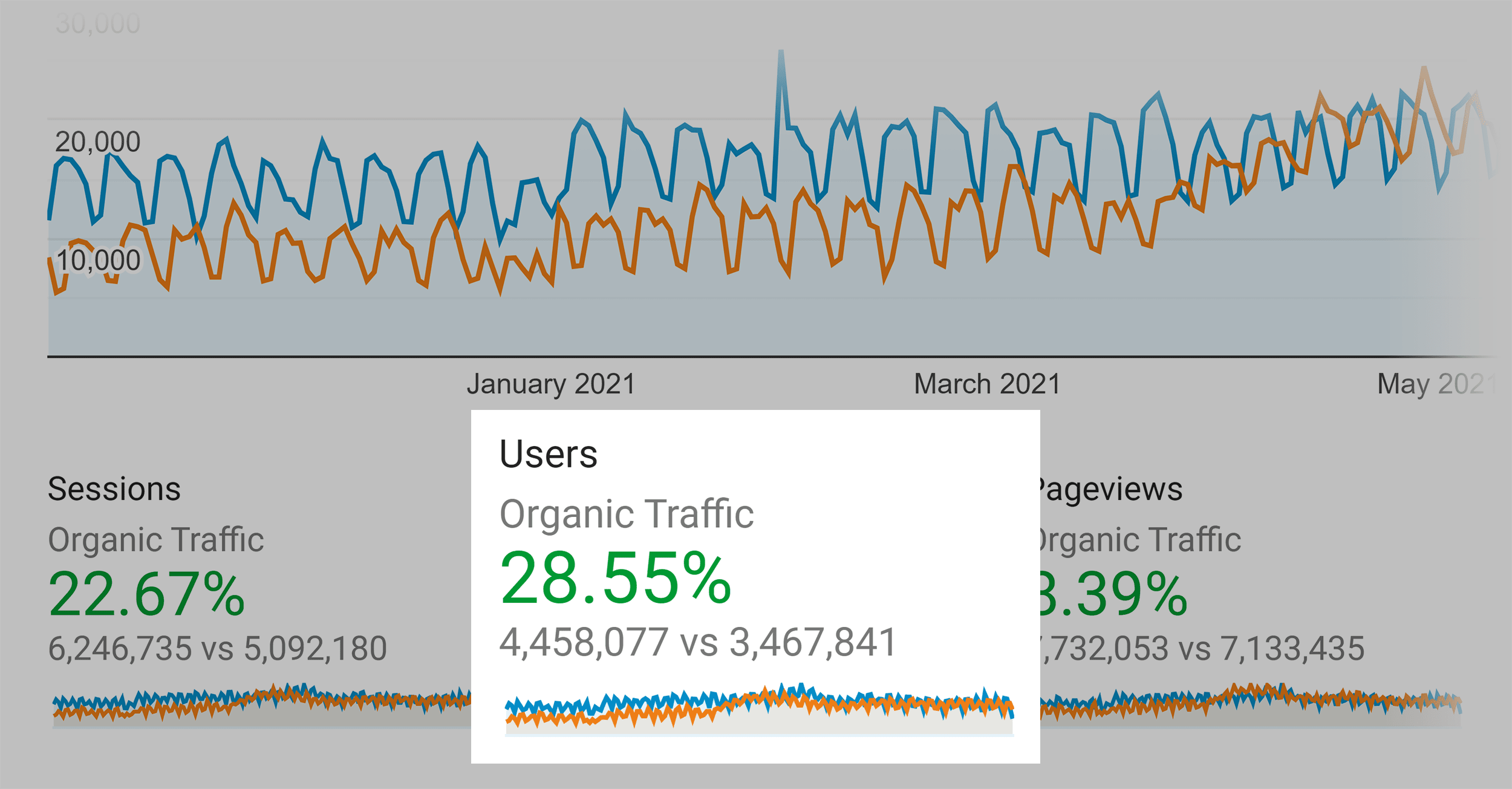
So if you want to get higher Google rankings, you’ll love the actionable steps in this guide.
Let’s get started.
- 1: Check To See If Your Site Is Mobile-Friendly
- 2: Make Sure Google Indexes ONE Version of Your Website
- 3: Speed Up Your Site
- 4: Find and Delete “Zombie Pages”
- 5: Find and Fix Indexing Problems
- 6: Check Your Organic Traffic
- 7: Improve Your On-Page SEO
- 8: Set Up Keyword Rank Tracking
- 9: Analyze Your Backlinks
- 10: Fix Broken Links
- 11: Competitor Analysis
- 12: Make Your Content 10x Better
- 13: Optimize For UX Signals
- 14: Flatten Your Website Architecture
- 15: Launch a Skyscraper Post
Step #1: Check To See If Your Site Is Mobile-Friendly
Mobile SEO is more important than ever.
Why?
First off, 60% of Google searches come from mobile devices.
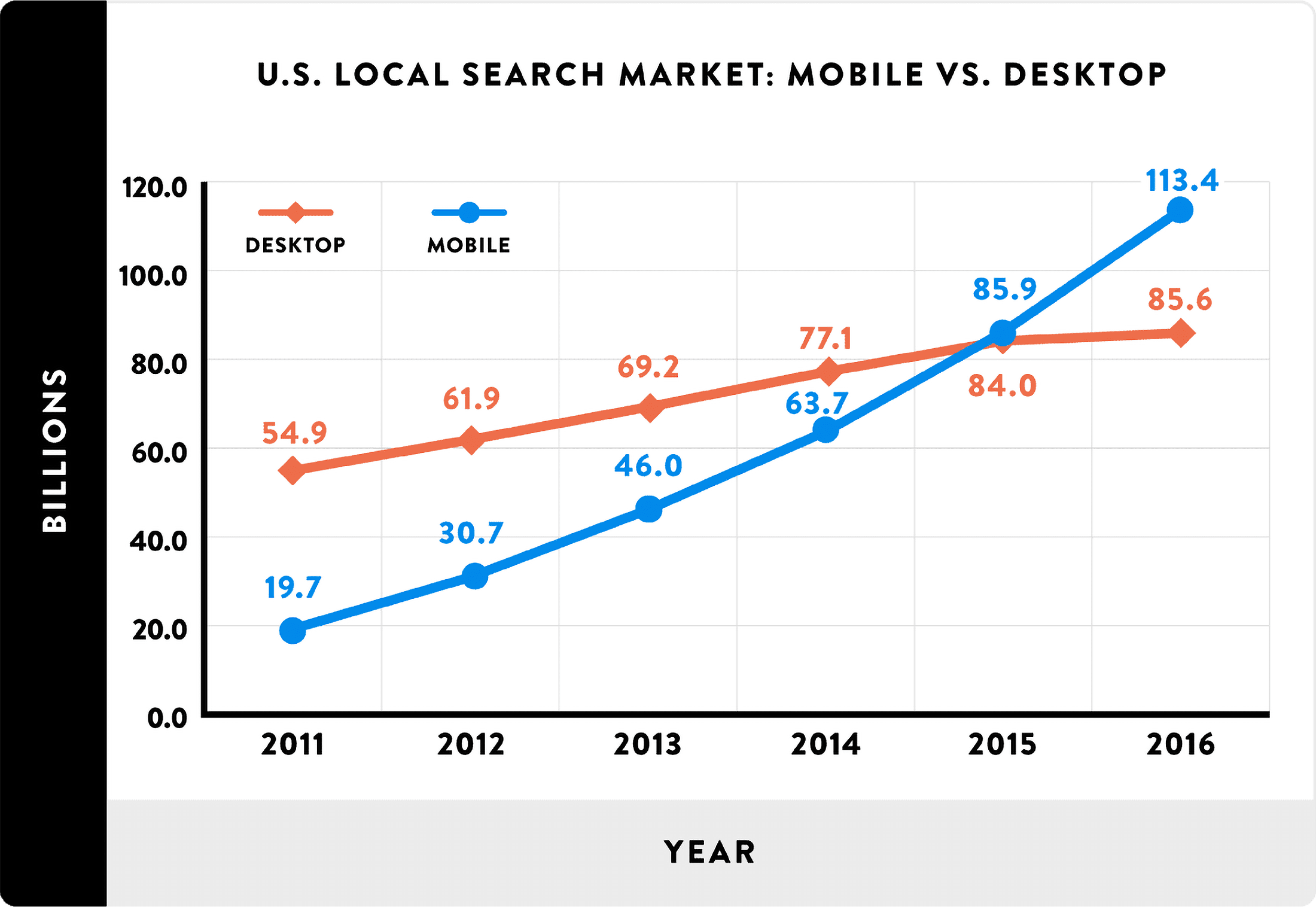
Second, Google started using their Mobile-First Algorithm.
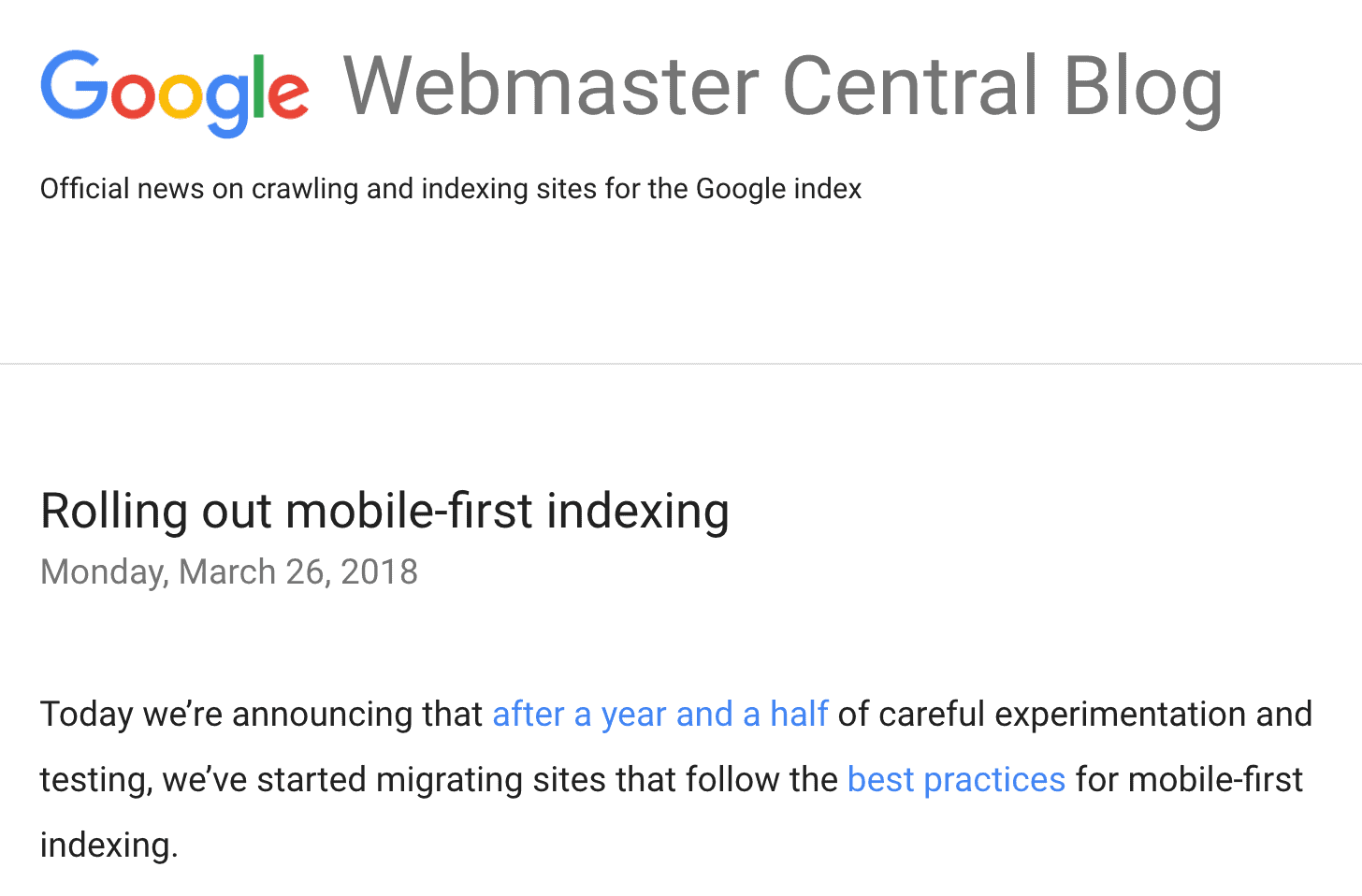
This means that Google now uses the mobile version of your site for mobile AND desktop searches.

The question is:
How do you know if your site is mobile-friendly?
Use Google’s Mobile-Friendly Testing Tool.

Step #2: Make Sure Google Indexes ONE Version of Your Website
Did you know it’s possible to have different versions of your site indexed in Google?
It’s true.
For example, here are 4 different versions of the same site:
- http://yoursite.com
- https://yoursite.com
- http://www.yoursite.com
- https://www.yoursite.com
To you and me, those URLs are pretty much the same.
But not to Google.
And unless you redirect these versions properly, Google will consider them completely separate websites.
(Not good.)
Fortunately, this is easy to check… and fix.
Just type each of the 4 different versions into your browser.
They should all end up on the same URL:

In my case, the “WWW” version of my site redirects to backlinko.com.


All good.
If a version of your site isn’t redirecting properly, no worries.
Just 301 redirect it to the version you want to use.
Then, move onto step #3.
Step #3: Speed Up Your Site
Years back Google confirmed that your site’s loading speed is a ranking factor.
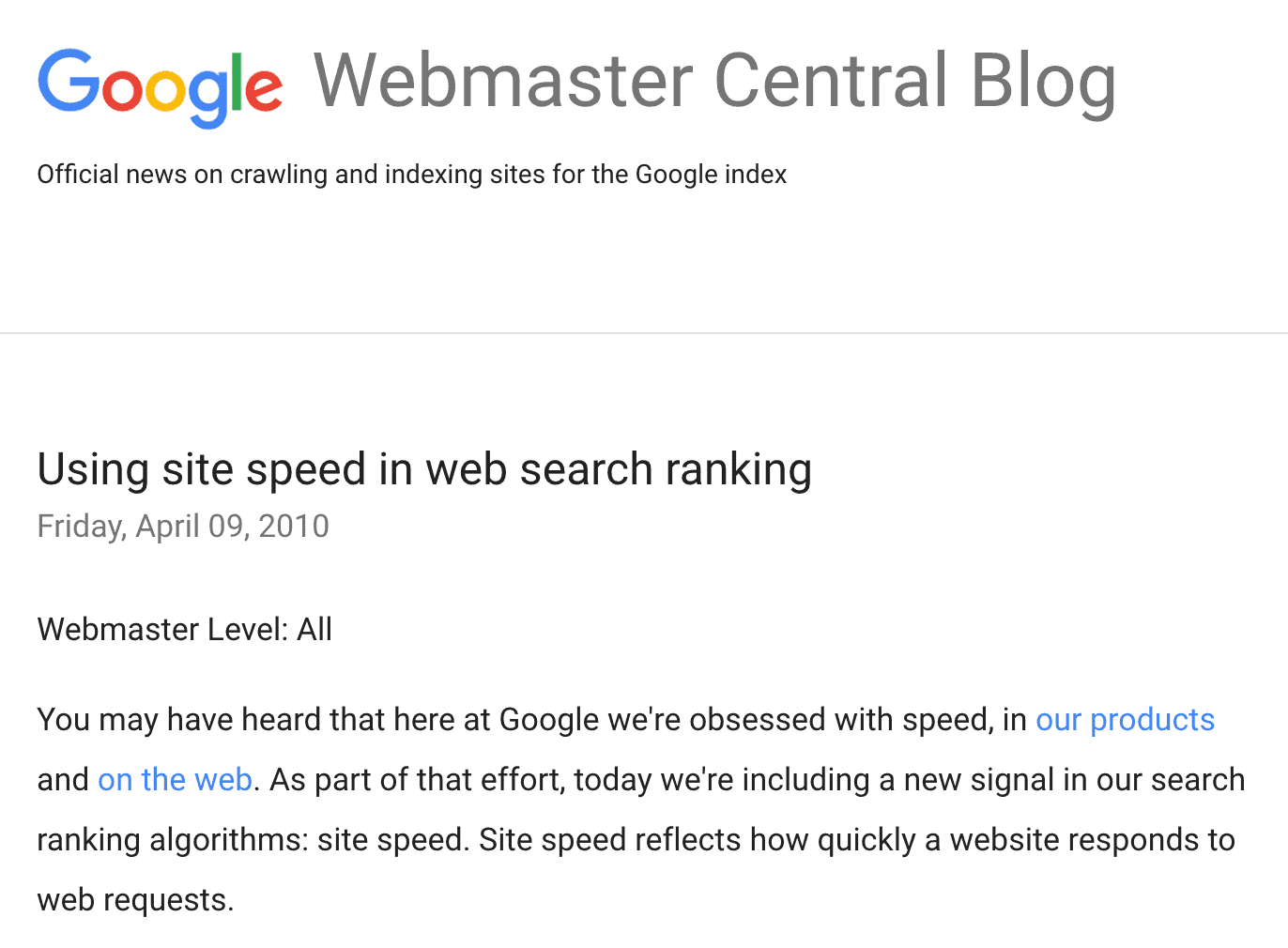
And a while ago they rolled out a new update that makes speed even MORE important.

Here’s how to get your site to load REALLY fast:
First, clean up your site’s HTML code.
You can easily find problems with your code with PageSpeed Insights.
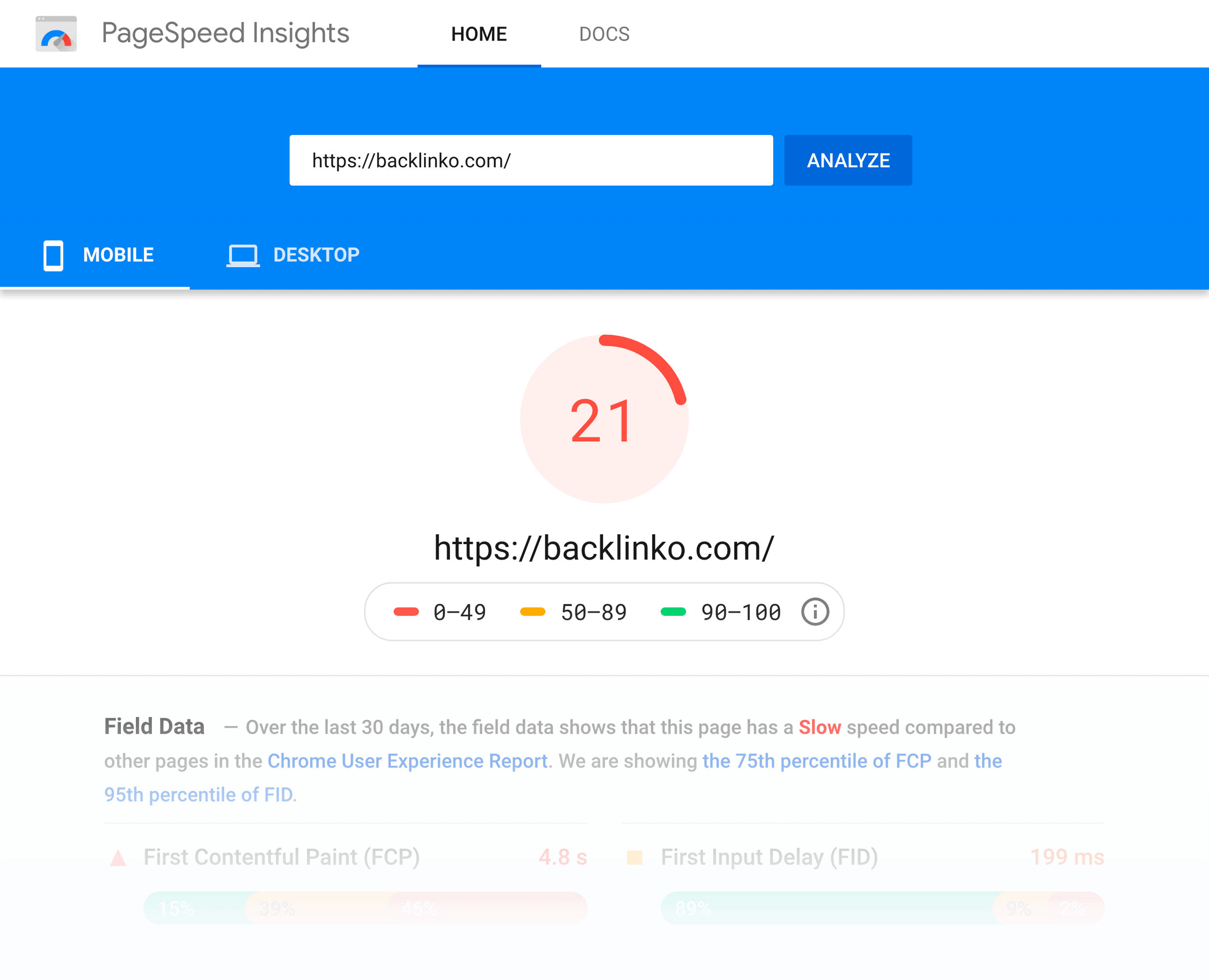
Pro Tip: Don’t just analyze your homepage. Make sure to also test popular pages from your site, like blog posts, service pages, and category pages.
Second, run a speed test.
This type of test actually loads your page… and lets you know about bottlenecks that slow things down.

I personally use WebPageTest.org. But GTMetrix is really good too.
Third, crunch your images.
Huge images can bring your site speed to a screeching halt.
That’s why I recommend compressing your images with a tool like Kraken.

Pro Tip: Upgrade your hosting. If you spend $10 per month on hosting, don’t expect fast loading times. A few years back I switched from a budget host to $200/month premium hosting. And the speed difference was insane.
Step #4: Find and Delete “Zombie Pages”
Type site:yourwebsite.com into Google.
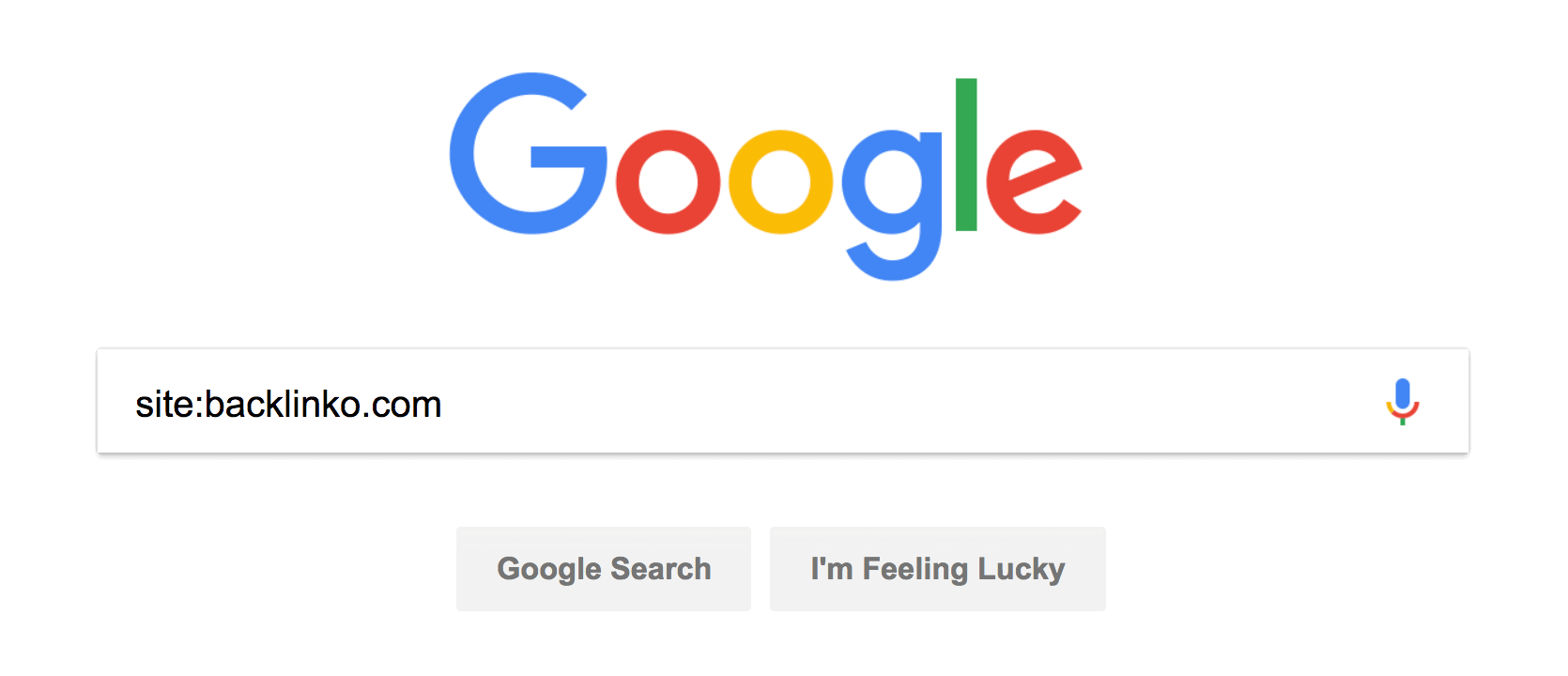
This will show you how many pages Google has indexed:
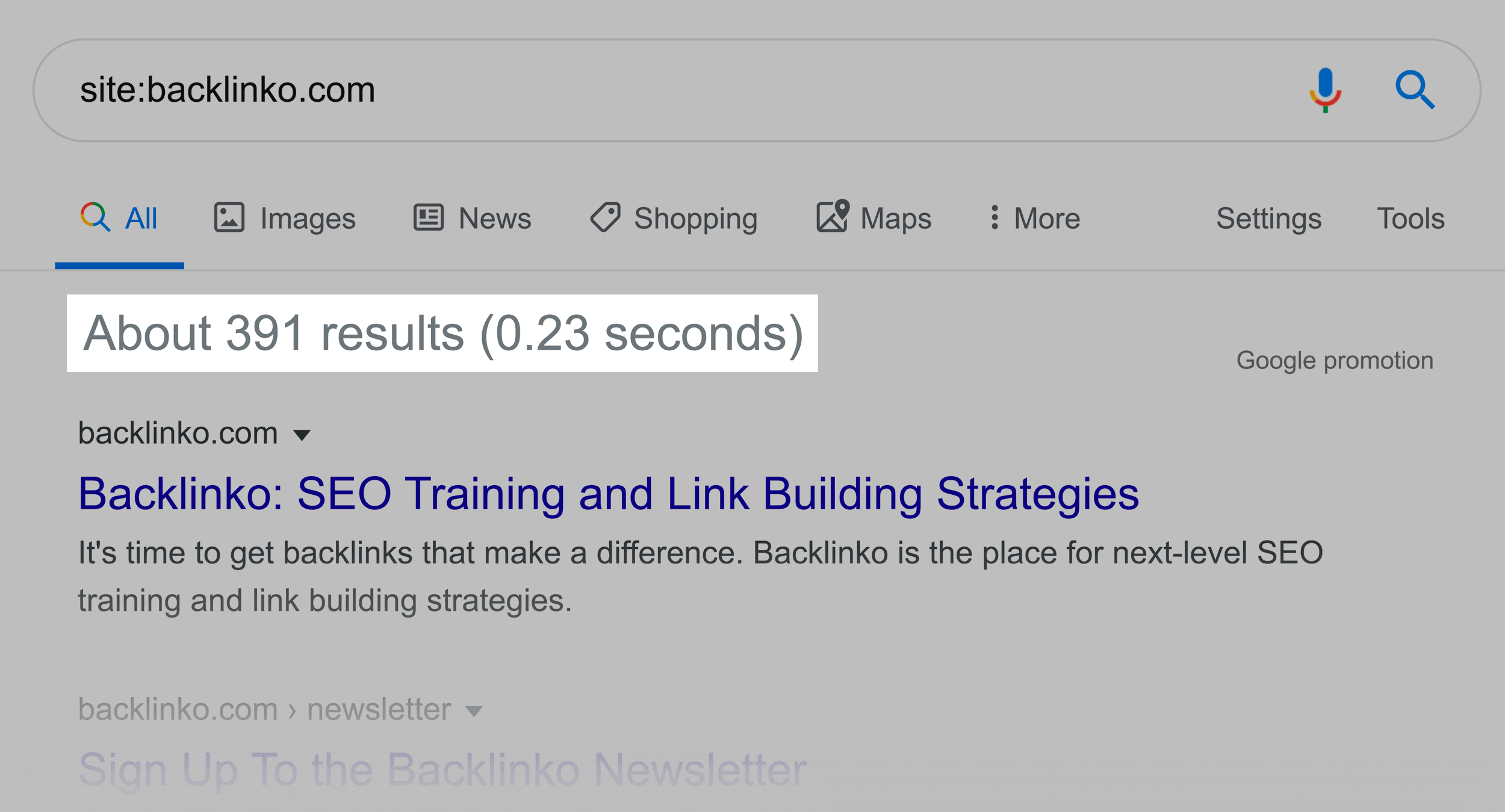
If this number is higher than you thought, you’re not alone.
In fact…
Many sites have 50-75% MORE indexed pages than they’d expect.
(I call these extra pages “Zombie Pages”.)
As it turns out, deleting Zombie Pages can get you A LOT more organic traffic.
For example, Sean from Proven deleted over 9k Zombie Pages from his site…
…which helped boost his Google traffic by nearly 50%:
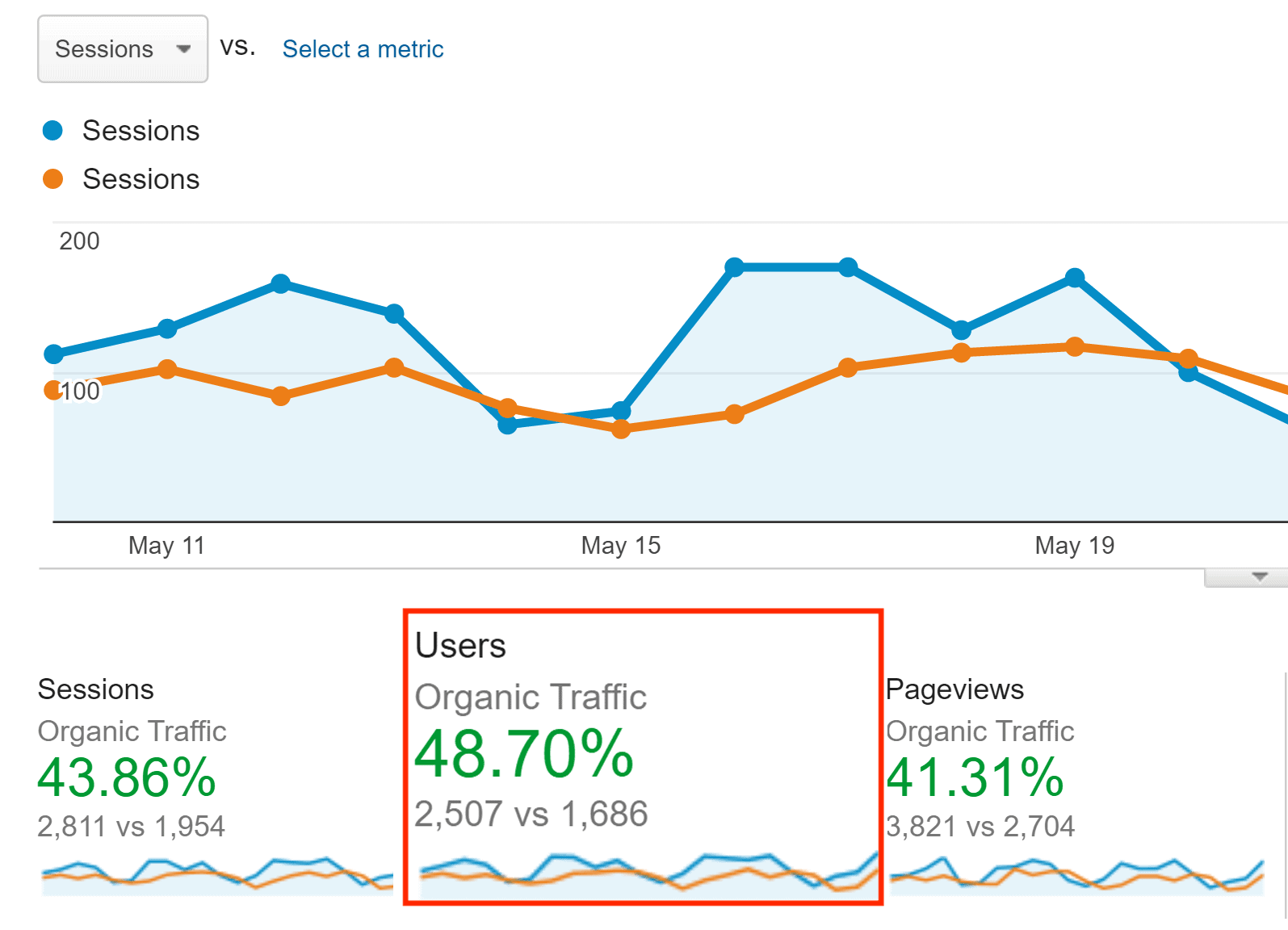
Why does this work so well?
Well, Google has said that more content doesn’t make your site better.

And when you delete Zombie Pages, you give Google what it wants.
Pro Tip: Deleting Zombie Pages also makes the rest of this SEO audit MUCH easier. Fewer pages=fewer problems
With that, here are the most common types of Zombie Pages:
- Archive pages
- Category and tag pages (WordPress)
- Search result pages
- Old press releases
- Boilerplate content
- Thin content (<50 words)
Which leads us to our second step…
Step #5: Find and Fix Indexing Problems
Next, it’s time to find web pages that Google isn’t indexing.
To do that, fire up the good ol’ Google Search Console.
The “Index Coverage” report shows you a list of pages that they can’t index for some reason.
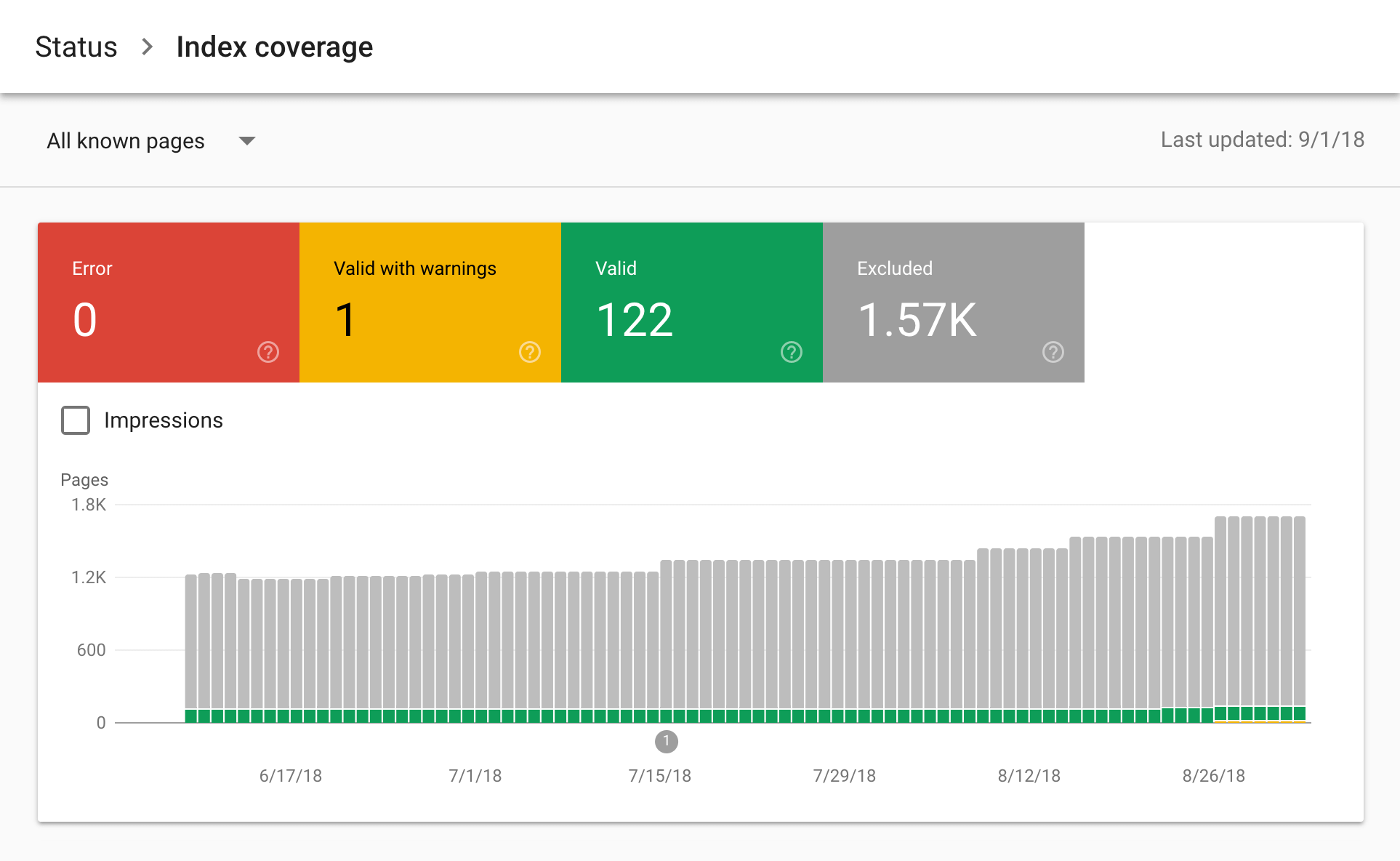
As you can see, Backlinko is pretty much error-free.
All good right?
Maybe.
To double check everything is A-OK, I recommend a free SEO tool called Screaming Frog.
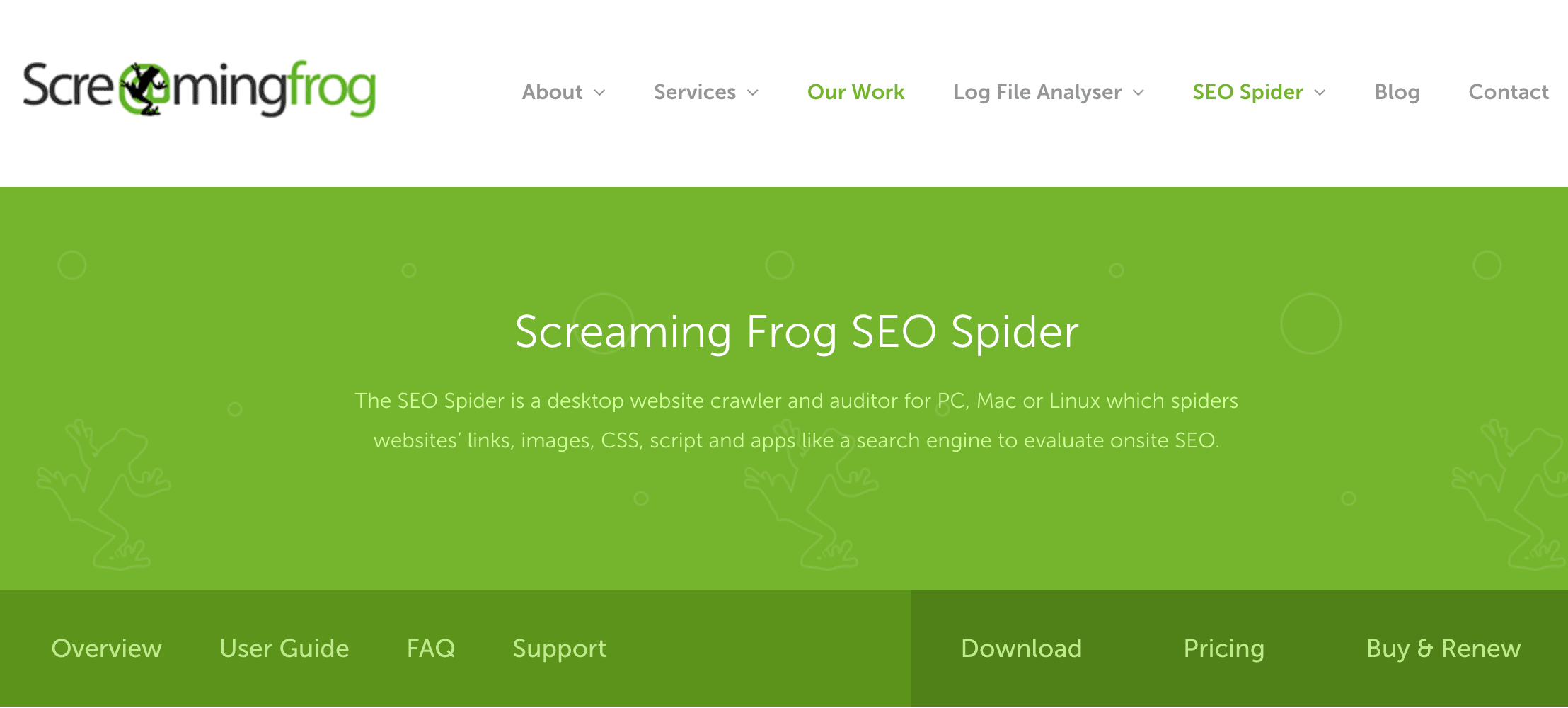
Screaming Frog crawls your site the same way Google would. And it lets you know about pages that it can’t access.
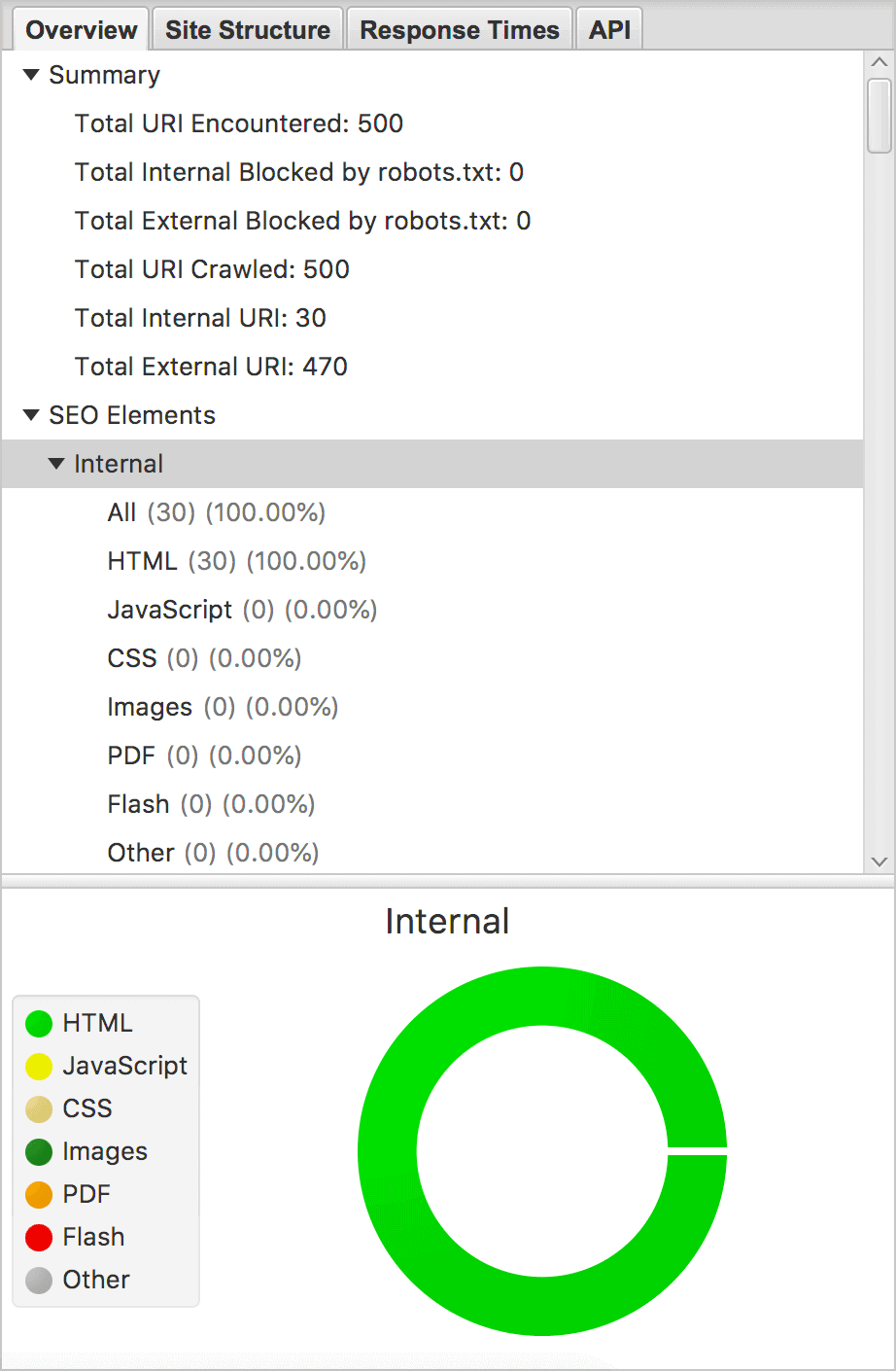
(For example, if you’re accidentally blocking a page with your robots.txt file… or the page has a noindex tag.)
So if you find a page that’s blocked, double-check that it’s meant to be blocked.
For example, we used to paginate comments here at Backlinko.
And I did’t want Google to index every single comment page. So we threw a noindex tag on those pages.

In this case, the pages that are blocked are meant to be blocked.
And once you’ve confirmed that Google can access all of the pages you want them to access, it’s time to…
Step #6: Check Your Organic Traffic
Now it’s time to see how much organic traffic you’re getting.
To do that, head over to Google Analytics.
Then, go to Acquisition >> All Traffic >> Channels.

Hit “Organic Search”.

And you’ll see how many people visited your site from search engines last month.

Next, set the dates to the last 6-8 months.
And you’ll see whether or not your organic traffic is trending in the right direction:

As you can see, my organic traffic has gradually increased over the last few months.
Now:
If your organic traffic is flat (or declining), no worries.
The goal in this step is just to establish benchmarks.
Things should start to improve once you finish this SEO audit.
Speaking of…
Step #7: Improve Your On-Page SEO
It’s no secret that on-page SEO is super important.
That said:
You probably don’t have time to optimize every page on your site.
Fortunately, you don’t have to.
Here’s what to do instead:
First, identify your 5 most important pages.
These can be pages that:
- Target an important keyword
- Get less traffic than they did back in the day
- Already rank well… but have the potential to crack the top 5
For example…
I published a list of best free SEO tools.
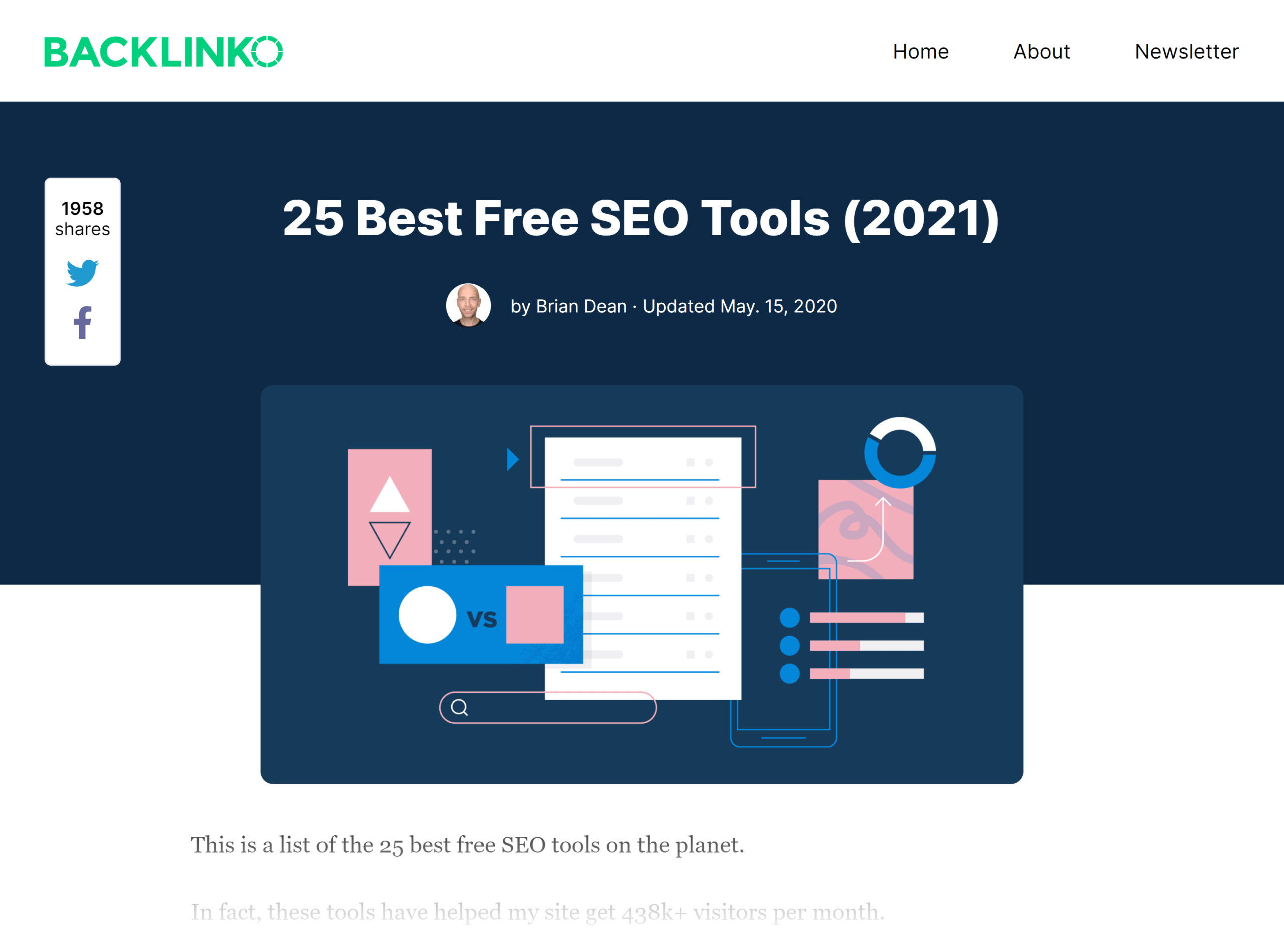
Besides the basics (like including my keyword in my title tag), I didn’t do much to optimize this page.
And because it’s already on the first page for my target keyword…

…it has a good chance of cracking the top 5.
Then, optimize your page with the strategies in this video.
Now:
If you’re REALLY pressed for time and don’t have time to implement everything from the video, focus on these 5 strategies:
- Include your keyword in your title tag
- Include your keyword in first 100 words
- Add 5+ external links
- Add 5+ internal links
- Use LSI keywords
Once those strategies are in place, let’s dive right into step #8:
Step #8: Set Up Keyword Rank Tracking
Now it’s time to start tracking your rankings in the SERPs.
There are a million rank tracking tools out there.
But to me, the best out there is probably SEMrush.
Why?
SEMrush is awesome because it doesn’t just track the keywords you give it.
(Although it does that too.)

What’s cool about SEMrush is that it automatically finds keywords that you rank for.
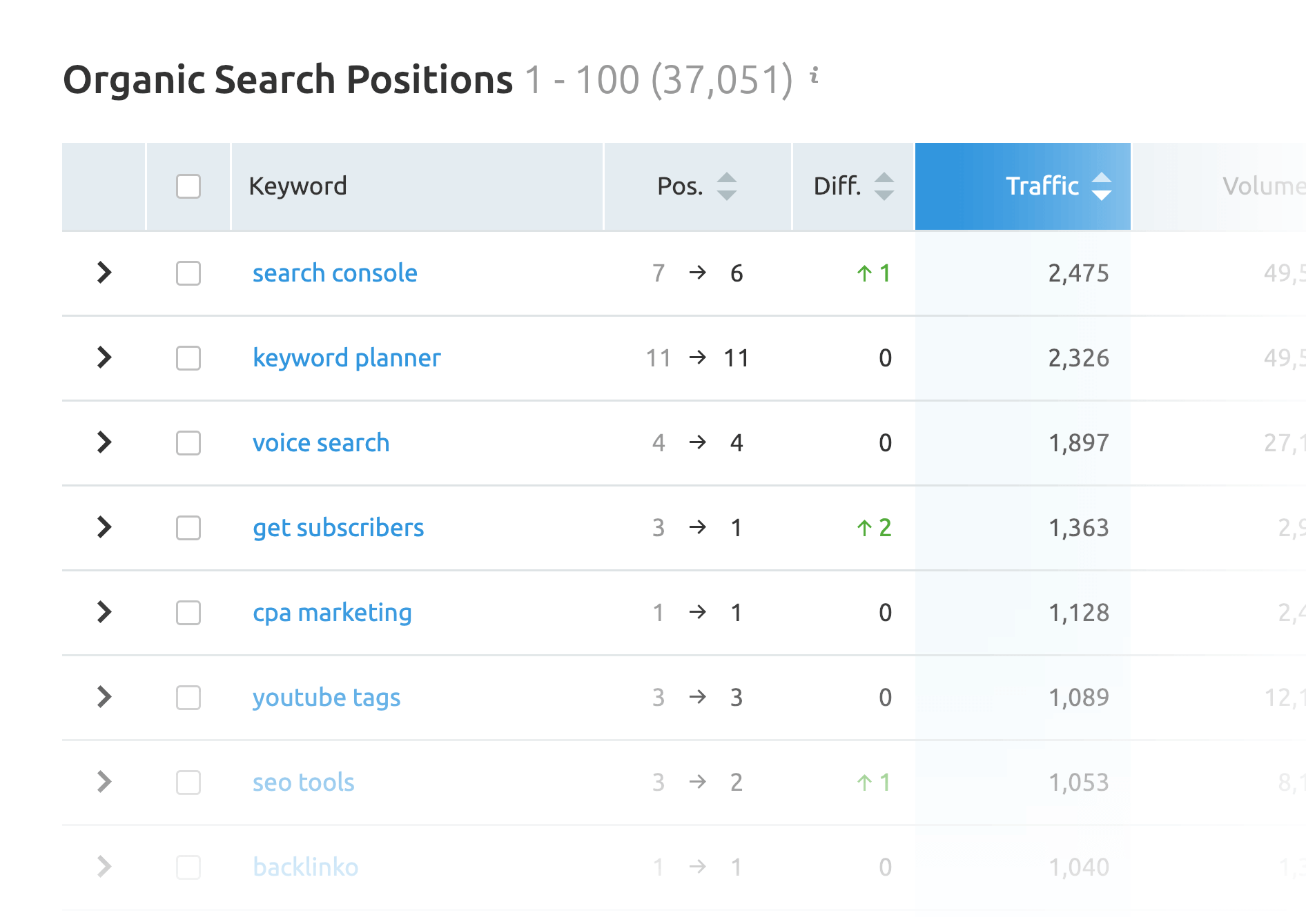
Nice.
Step #9: Analyze Your Backlinks
There’s no doubt about it:
Backlinks are still REALLY important.
In fact, our study of 11.8 million search results found that backlinks correlate with rankings more than any other factor.

And now it’s time to analyze your backlink profile.
Here’s how:
First, enter your homepage into a backlink analysis tool.
(I’m using Semrush for this step. But you can also use any other SEO tool out there.)
And you’ll get a report on your links:

Then, check out referring domains and Domain Authority.
Referring domains = the number of different websites that link to you.

Don’t sweat the exact number too much. You’re just benchmarking where you’re at.
You also want to take a look at your Domain Authority.

Every tool has its own name for “Domain Authority”.
(For example, Semrush calls it “Authority Score”.)
But the idea is the same:
Domain Authority tells you how much authority your site has… based on a combination of the quantity AND quality of your backlinks.
Finally, look for toxic links.
To do that, check out the most common anchor text in your link profile:

If you see a lot of branded anchor text (like “Backlinko” and “Backlinko.com”), you’re good.
Fortunately, that’s the case with my link profile:

But if you notice lots of keyword-rich anchor text (like “SEO blog” and “SEO training company”), that’s a sign of a toxic link profile.
Here’s an example of a link profile with spammy anchor text:
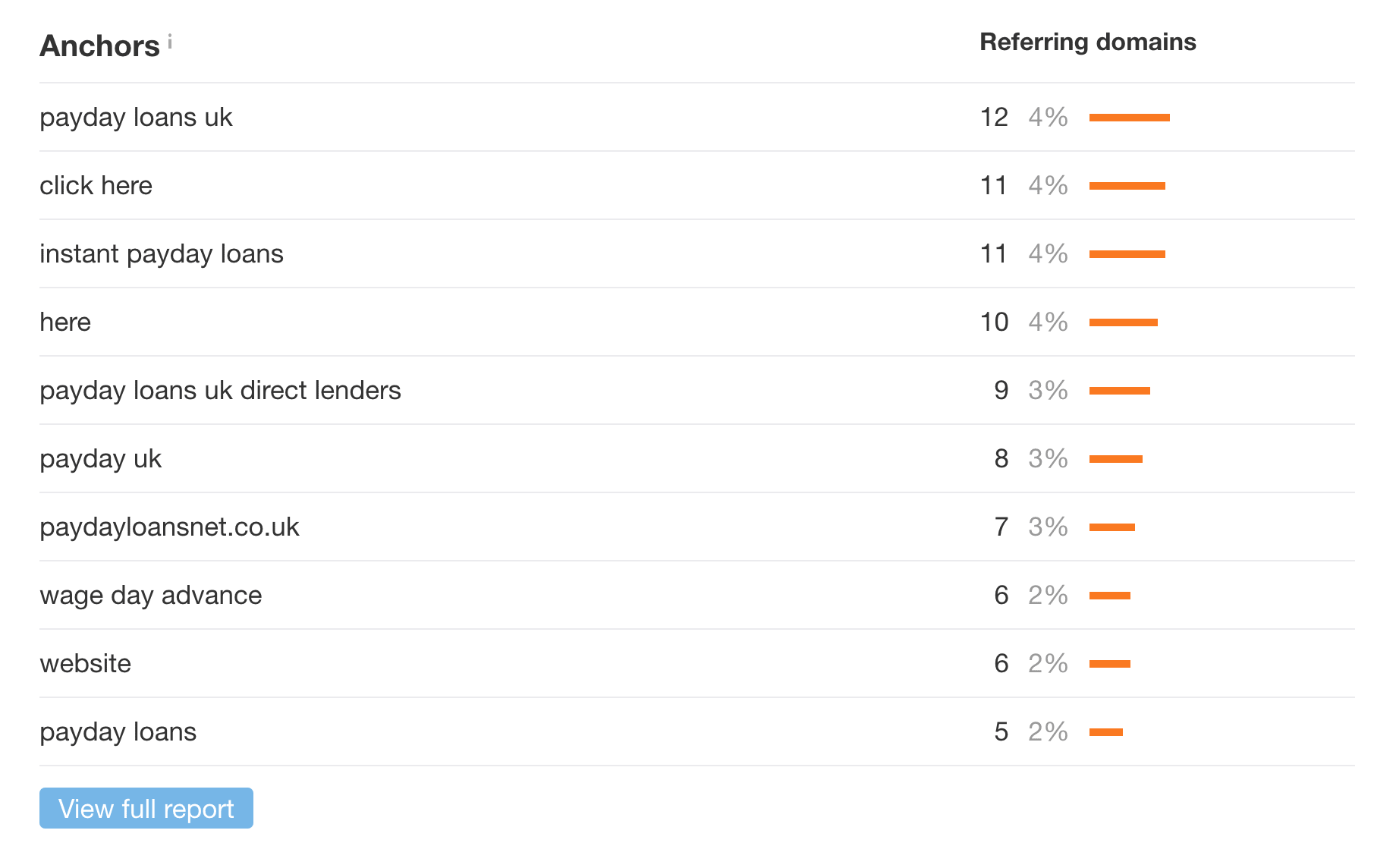
And if you want to dig deeper, take a look at some of your backlinks.
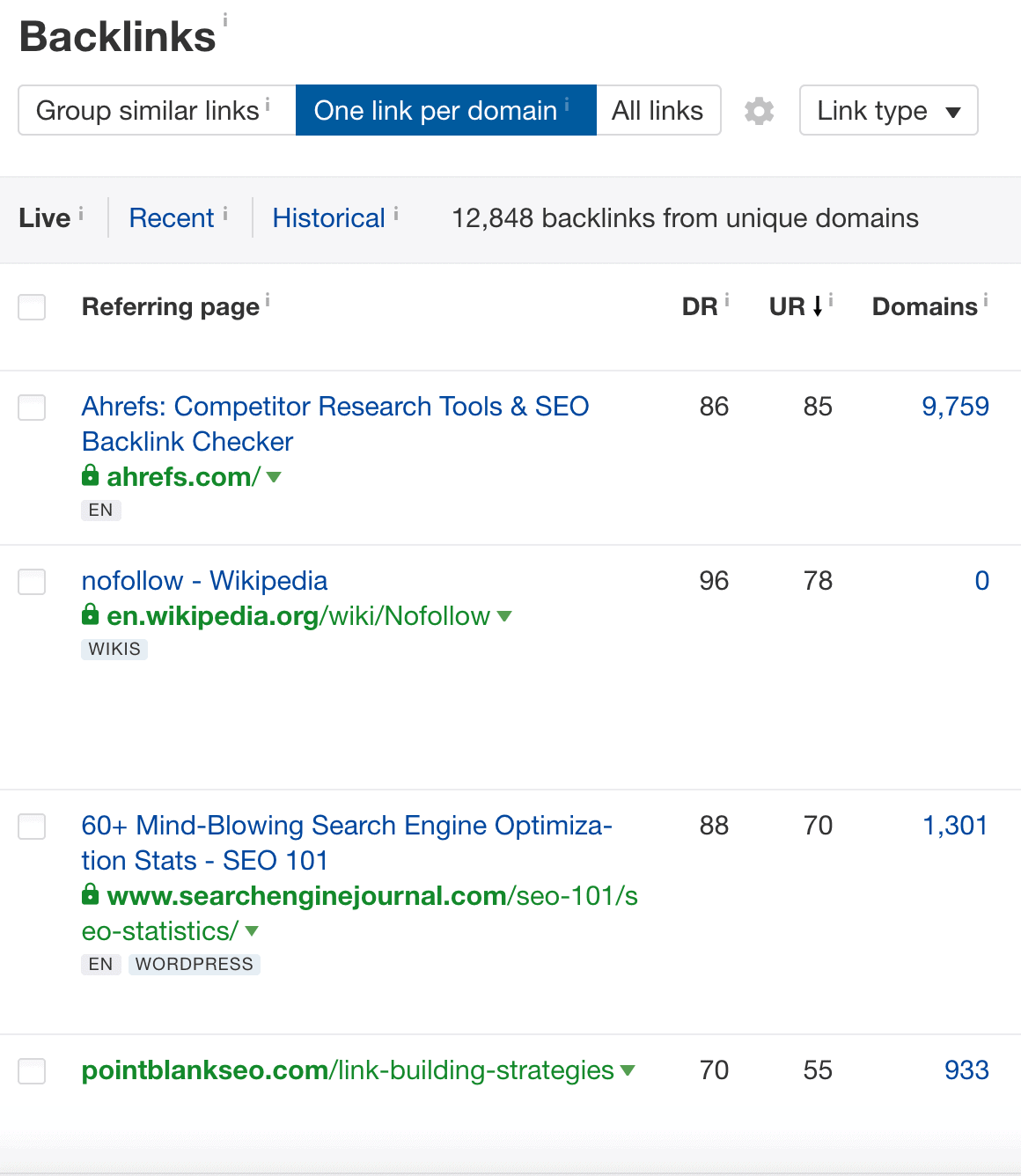
Most of your backlinks should come from REAL websites.
For example, you can see that most of my links come from blogs and news sites that write about digital marketing and SEO.
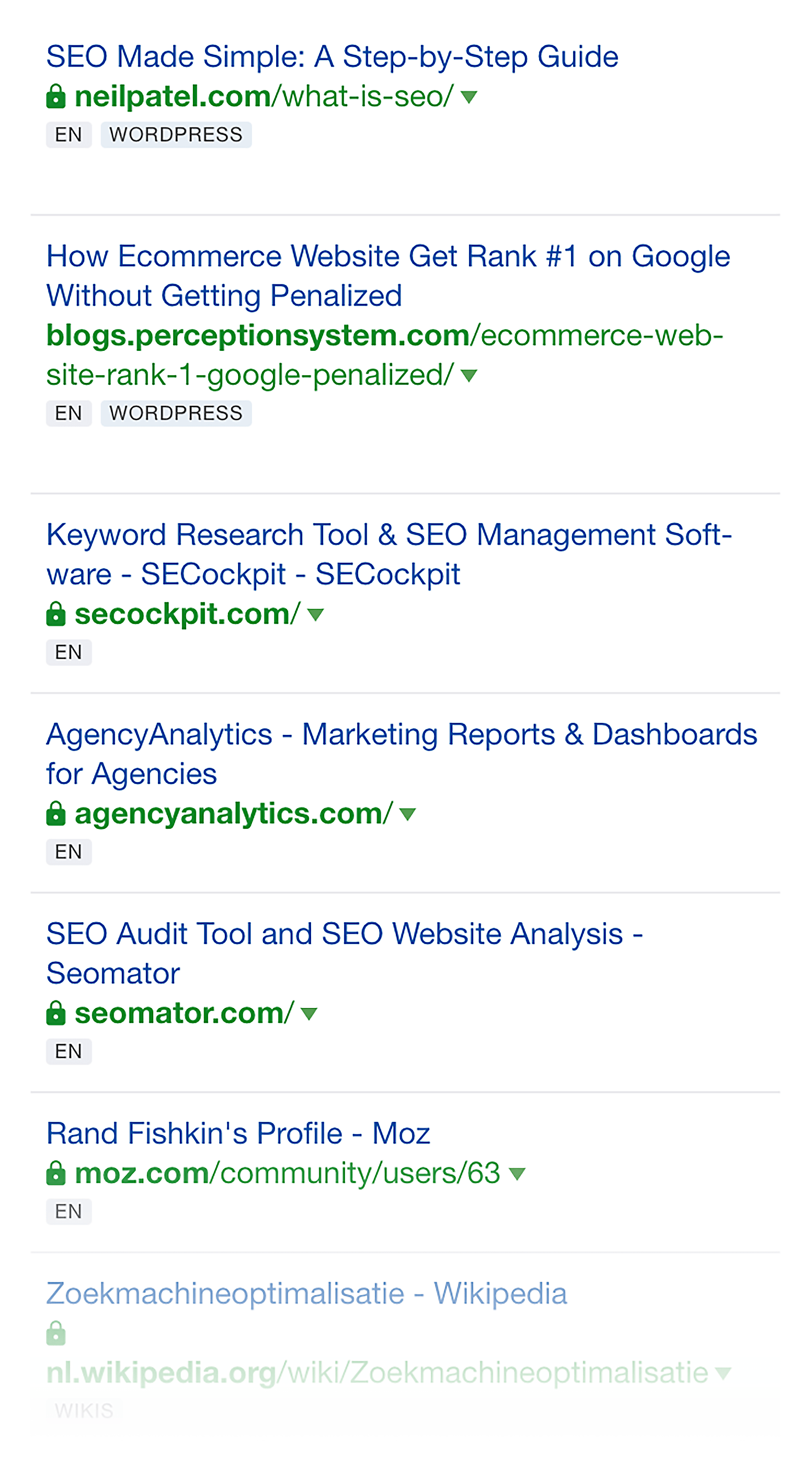
(Which is good.)
But if you notice that most of your links are from shady sites, you might want to disavow those links.
Pro Tip: Spammy links are a normal part of any link profile. So don’t stress if you see a few black hat links.
Step #10: Fix Broken Links
A few years back Google stated that they don’t “lose sleep” over broken links.
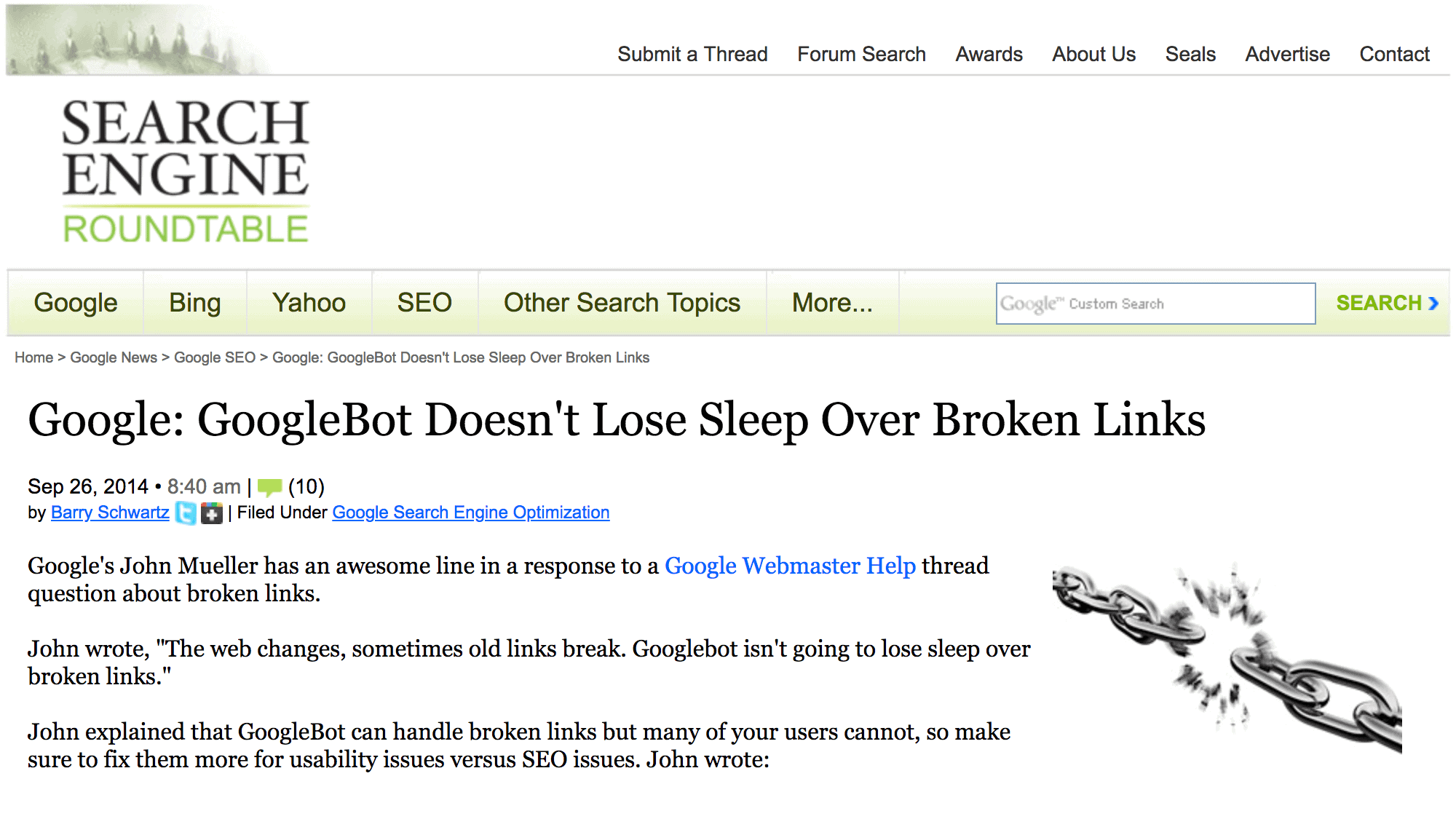
That said:
Broken links are bad for user experience… which CAN hurt your SEO.
(More on that later.)
With that, here’s how to fix broken links on your site:
First, find broken pages on your site that Google can’t index.
You can find this info in the Google Search Console’s “Index Report”.
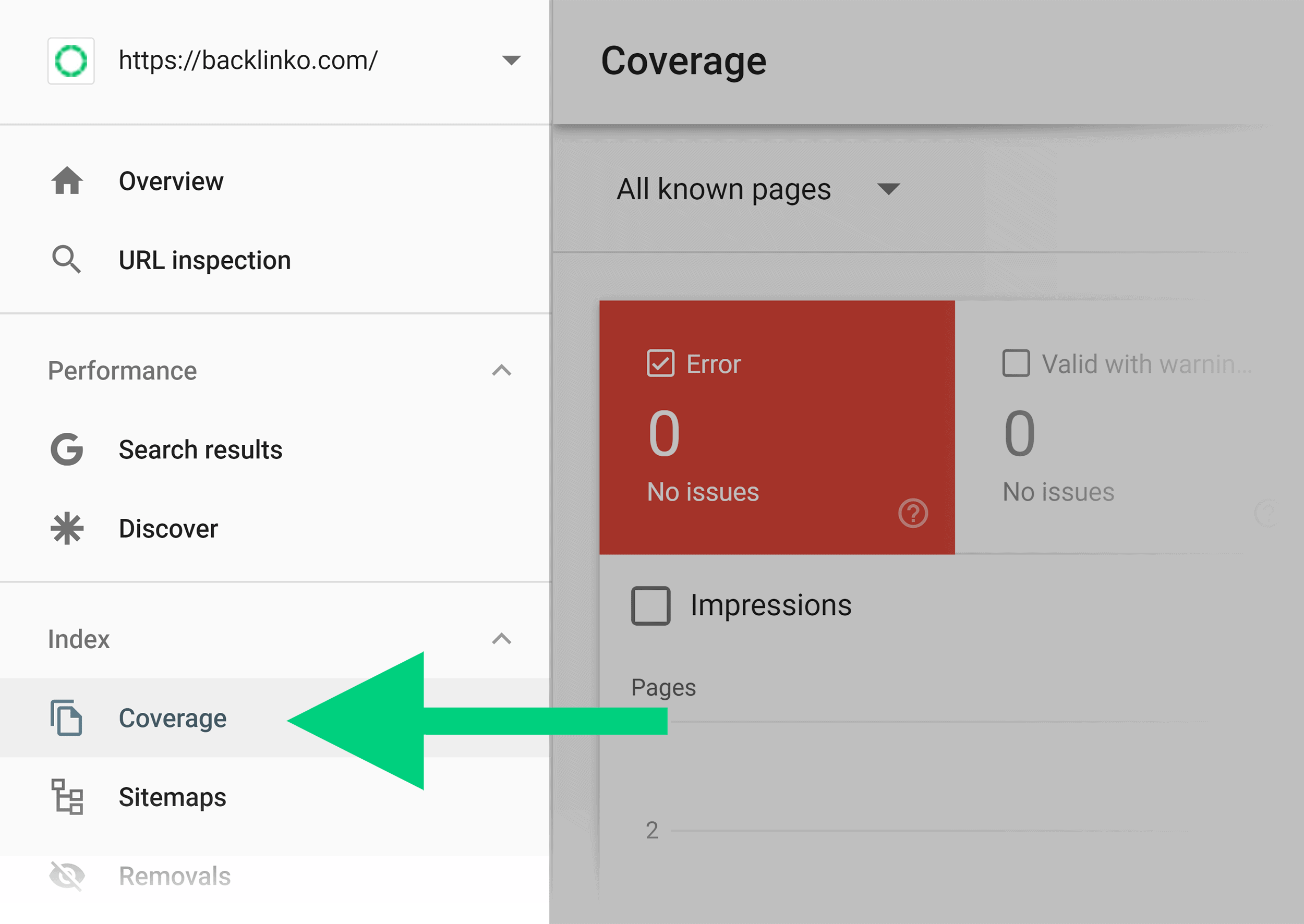
I stay on top of broken links, so I’m in the clear.
Here’s what you’ll see if your pages are giving Google 404 errors:

Sometimes you deleted pages for a reason (for example, you deleted a bunch of Zombie Pages).
If so, you don’t need to do anything. Google will eventually stop reporting these broken pages as problems.
But if Google can’t access a page that you want to rank, you obviously want to get that page back up ASAP.
Next, use a tool to find broken internal and external links.
You can use Semrush or a free tool like Broken Link Check.
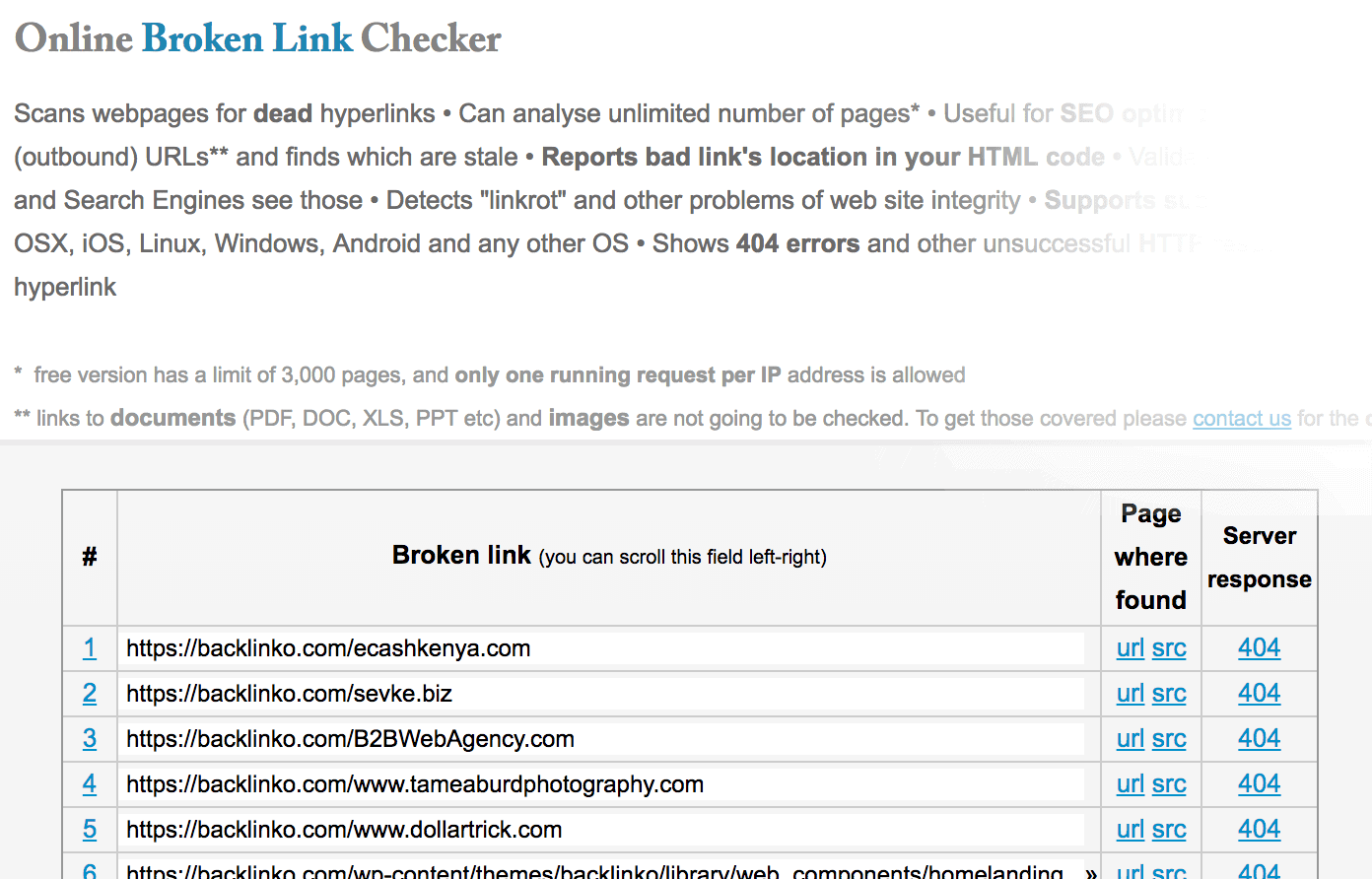
Both work.
Step #11: Competitor Analysis
Now it’s time to spy on your competitors.
Here’s how to do it:
First, find your competitors’ best keywords.
You can easily find this info using Semrush.
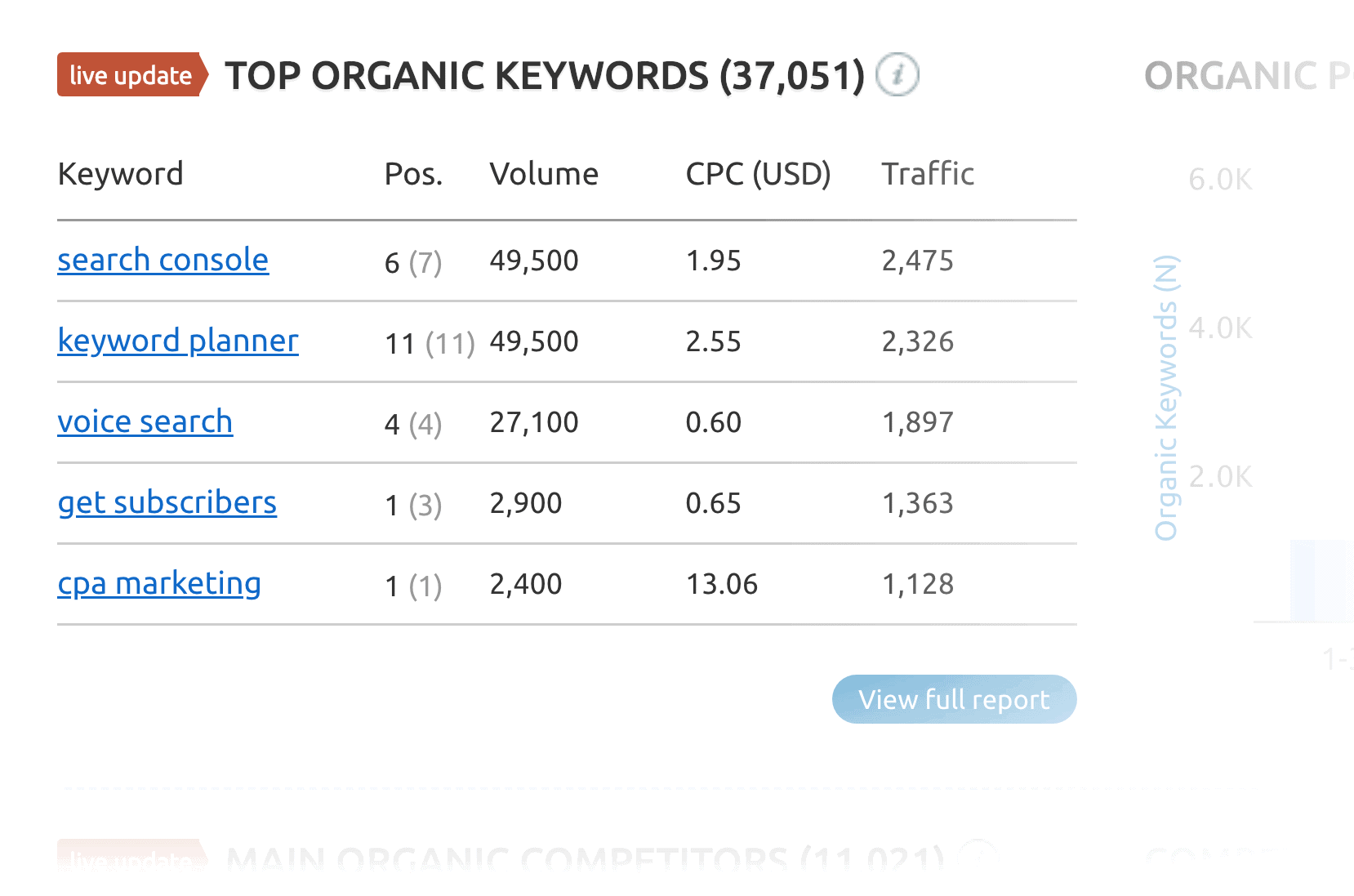
Needless to say:
If your competitors rank for these keywords, you have a good chance to rank for them too.
Which makes them GREAT keywords to target.
Second, check out the pages that are ranking for those terms.
Then, figure out what those pages have in common. That way, you know what type of content works best in your niche.
- Is long-form (3k+ words)
- Contains custom visuals and illustrations
- Cites research studies, data and statements from Google
- Isn’t super technical
Finally, see who links to those pages.
To do that, pop a URL into Semrush.

And take a look at the links pointing to that page.

This tells you who the influencers in your niche are. That way, you can start to build relationships with them.
(Which will come in handy when you get started with link building.)
Step #12: Make Your Content 10x Better
Back in step #7, you SEO-optimized your most important pages.
And now it’s time to make the content on those pages 10x better.
Why?
It’s simple:
To rank in 2022, your content needs to kick butt.
With that, here’s how to make those pages 10x better:
1. VERY short intros.
No one wants to read long-winded introductions like these:

Instead, keep your intros short and sweet:
2. Small paragraphs.
People don’t read online. They skim.
And small paragraphs help skimmers consume your content better.
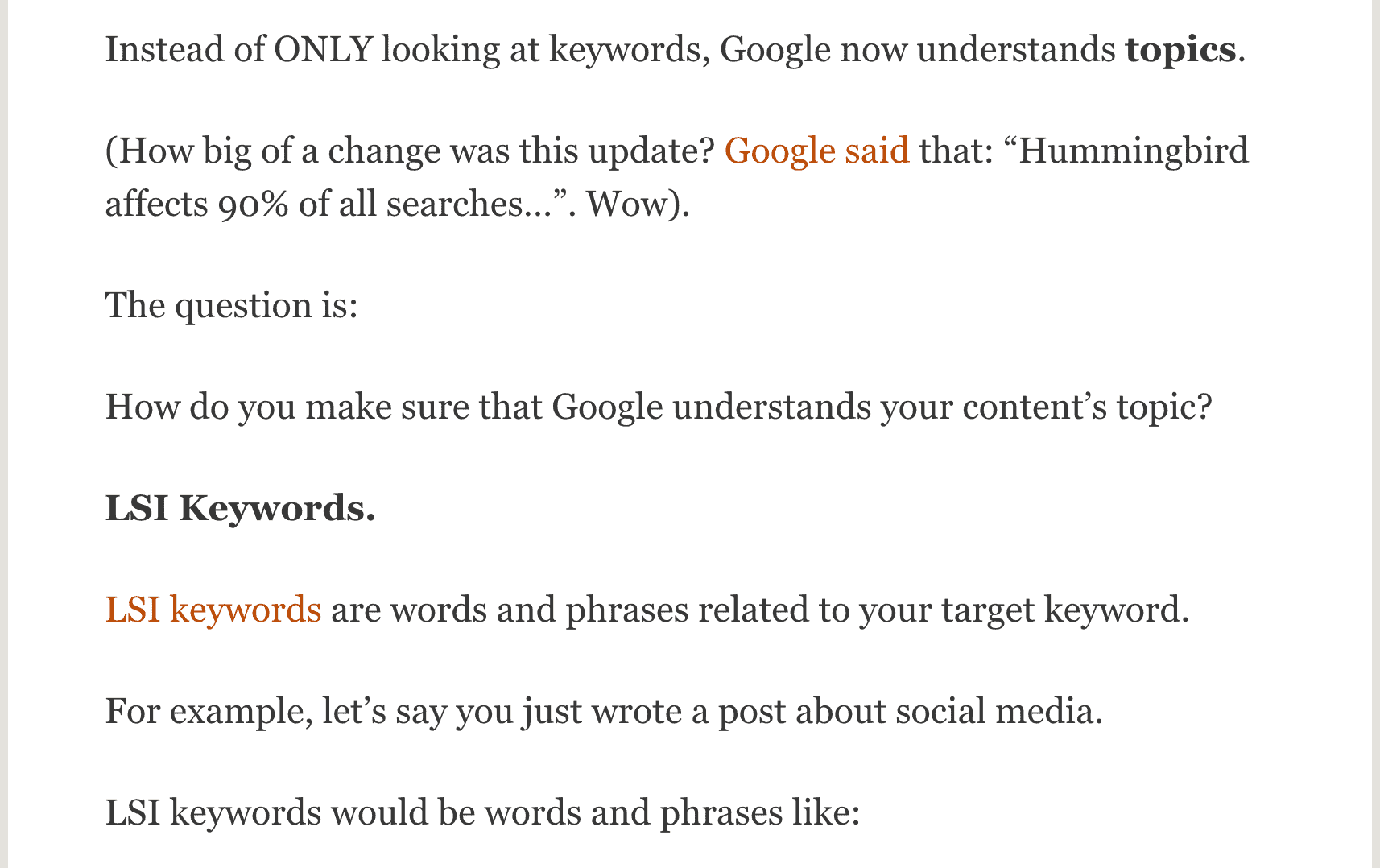
3. Lots of subheaders.
Subheaders help break up your content into digestible chunks.
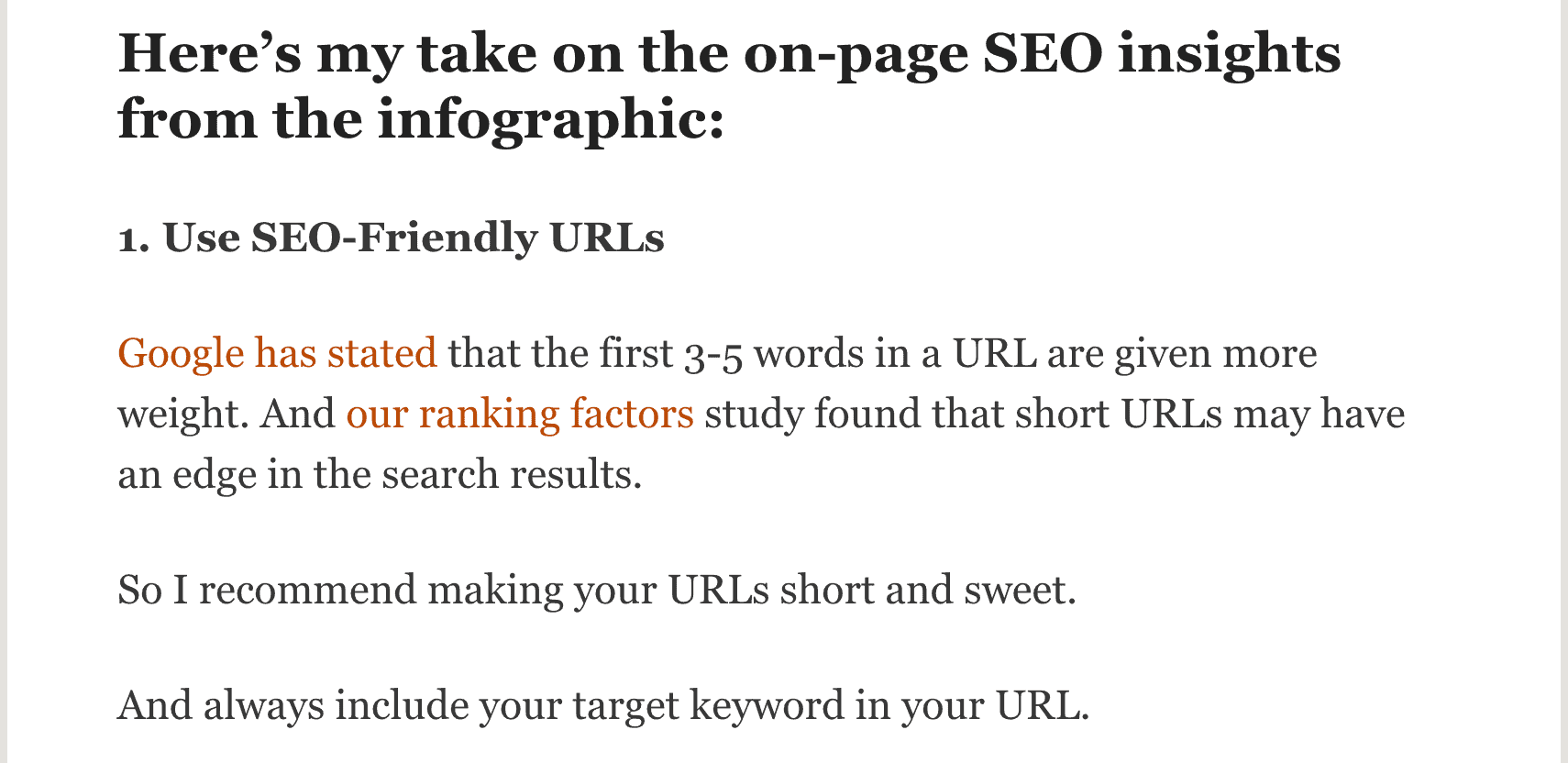
Use them early and often.
4. Use visuals, images and video
Multimedia makes your content MUCH more compelling.
(Plus, visuals help people learn and understand.)
For example, in this SEO checklist post, I use lots of images:
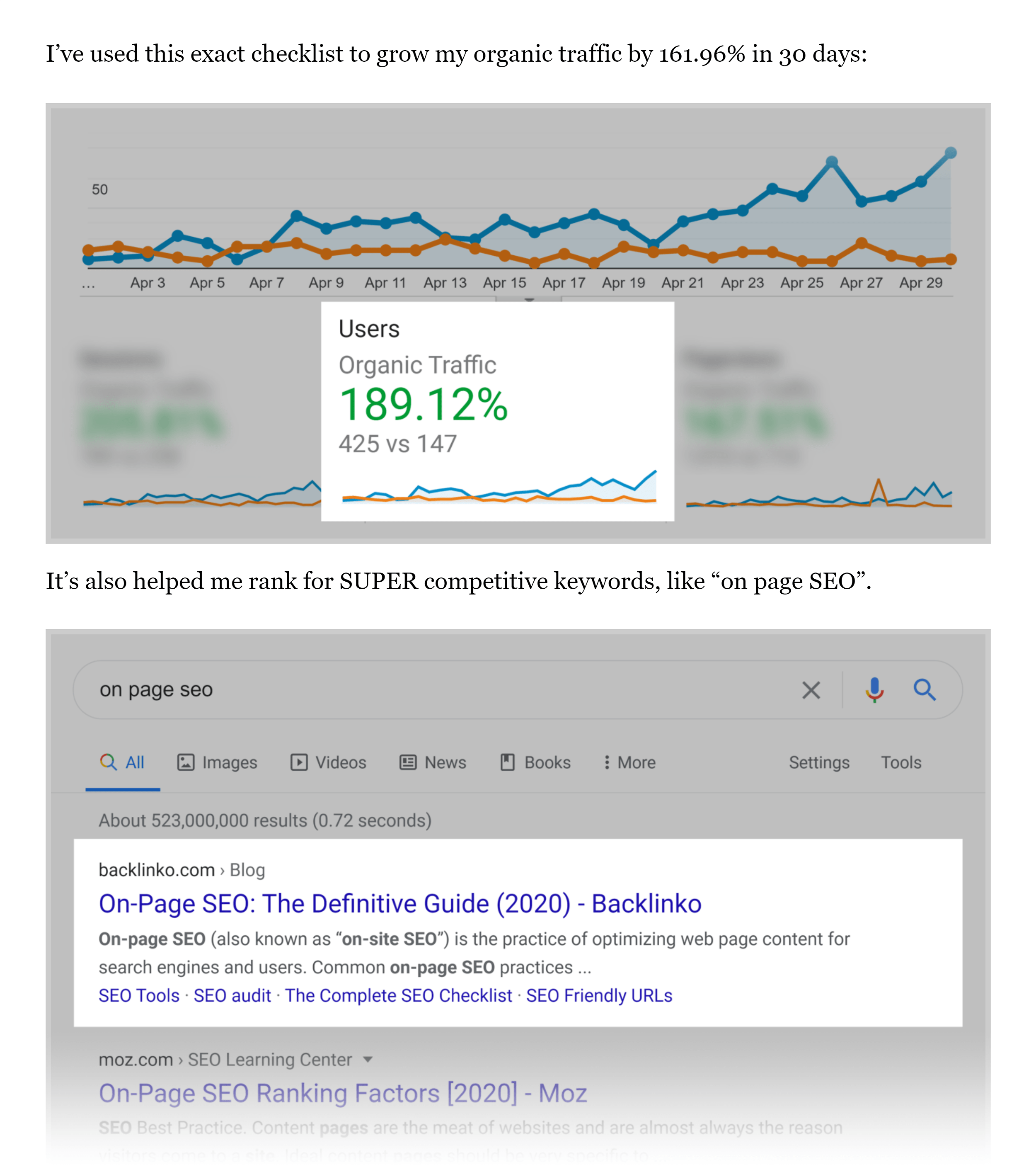
Visuals:

And videos:

And because my content is easy to read and understand, the average user spends 05:08 on that page:

Step #13: Optimize For UX Signals
RankBrain is Google’s AI algorithm.
Unlike the old Google, RankBrain measures how users interact with your site.
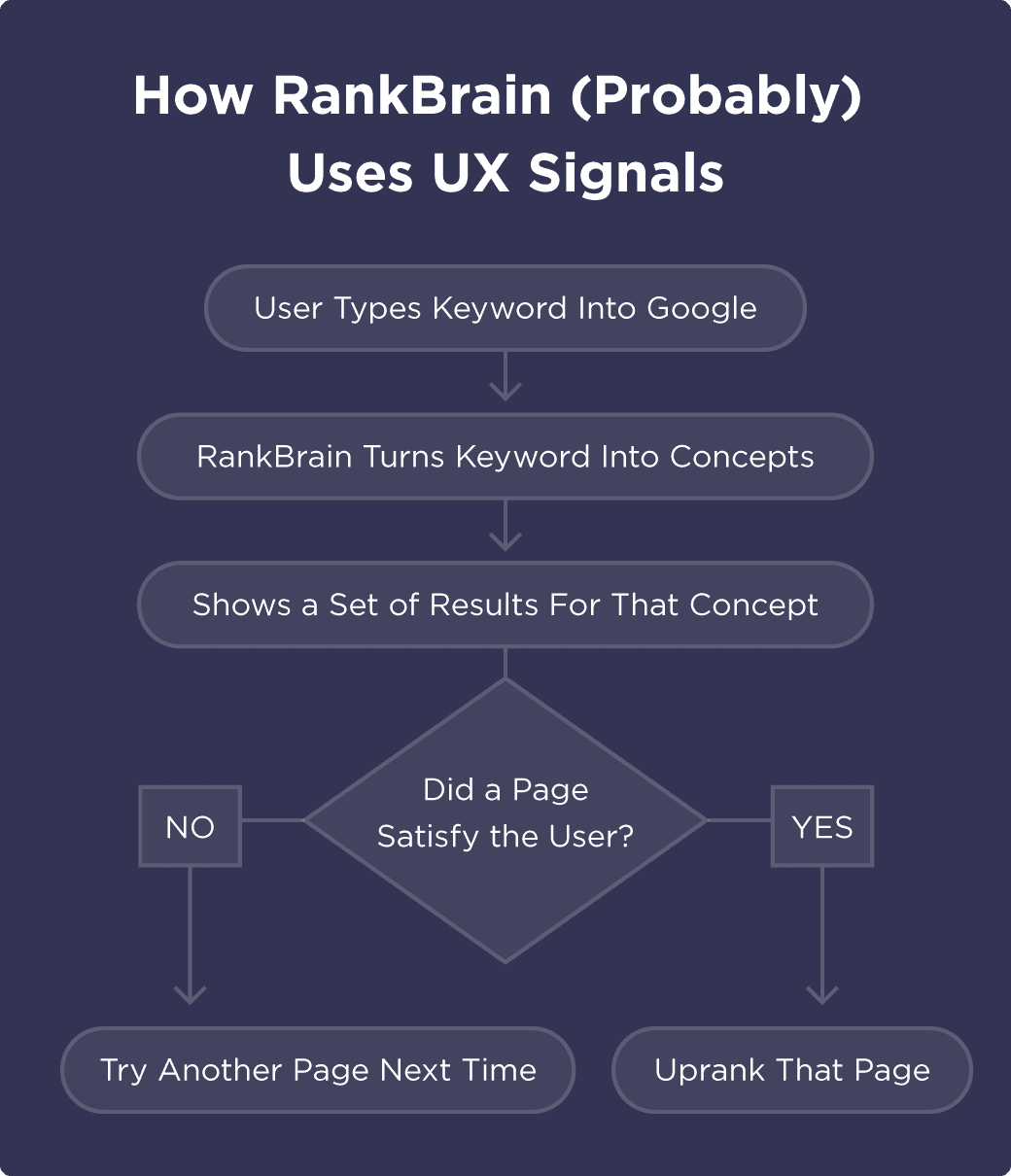
Which means:
To rank in Google today, you need to optimize for UX Signals.
In other words, your content needs to make users happy.
When you do, Google’s going to give you a HUGE rankings boost.
For example…
A while back I noticed that this post on my site wasn’t ranking that well.
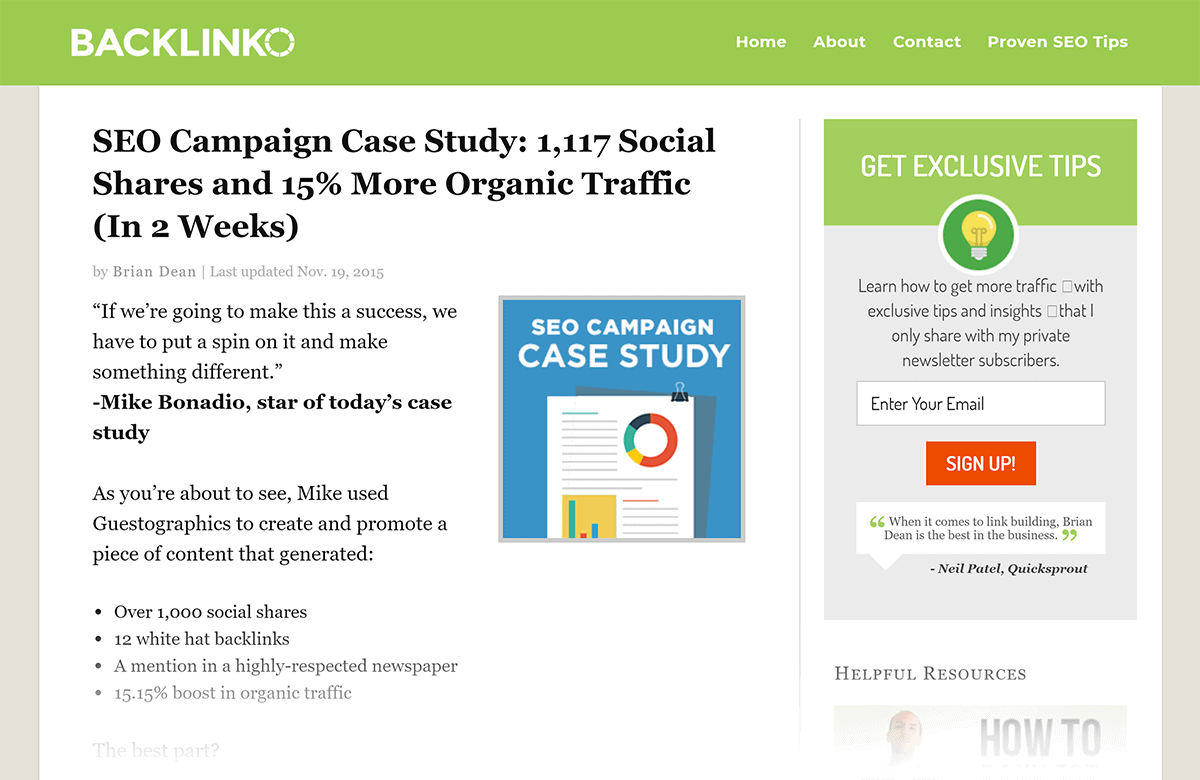
(It was hovering between the 10th and 15th spots for my target keyword: “SEO Campaign”.)

And when I looked at my content, I realized why…
My content didn’t give people searching for “SEO campaign” what they wanted.
Instead of steps, they got a case study of ONE specific strategy:
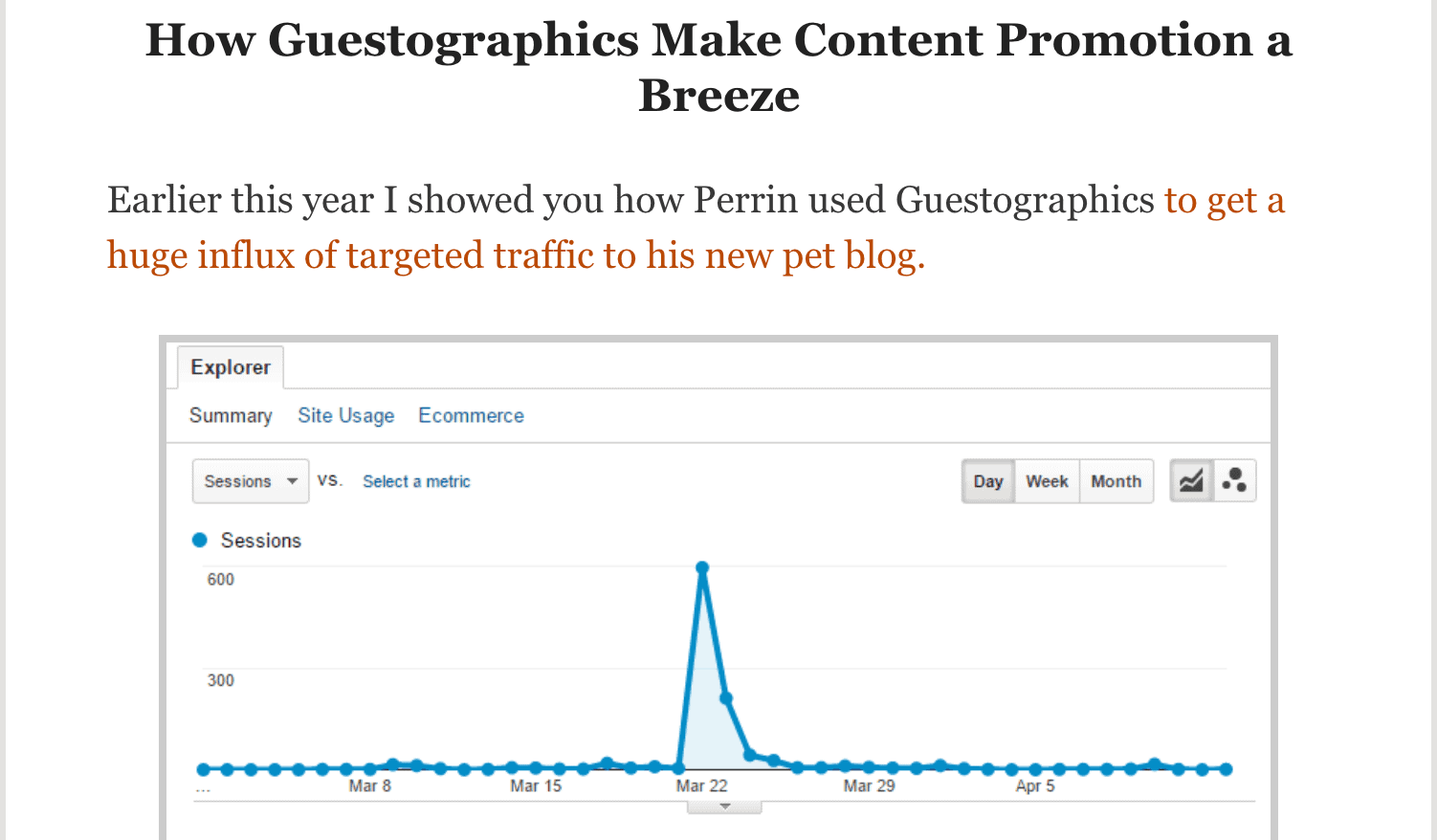
My post also had lots of outdated screenshots:

In short:
Because my content wasn’t optimized for UX signals, Google buried it.
So I decided to overhaul the entire post.
Specifically, I:
- Replaced the case study with a step-by-step guide
- Included more actionable tips for beginner and intermediate SEOs
- Added examples from several different industries
- Lots more
In the end, I had a piece of up-to-date content that was a PERFECT fit for someone searching for “SEO campaign”
Sure enough, because my content is designed to make Google searchers happy, my page quickly went from #15 to the #4 spot in Google.
And in a while it hit the #1 spot:

Very cool.
Step #14: Flatten Your Website Architecture
Your site architecture is simple:
It’s how the pages on your site are organized.
As it turns out, your website architecture is REALLY important for SEO.
Why?
Two reasons:
First, site architecture helps search engines find and index all of your pages.
When your site’s architecture is a big ol’ mess, Google’s gonna have trouble finding all of your pages:
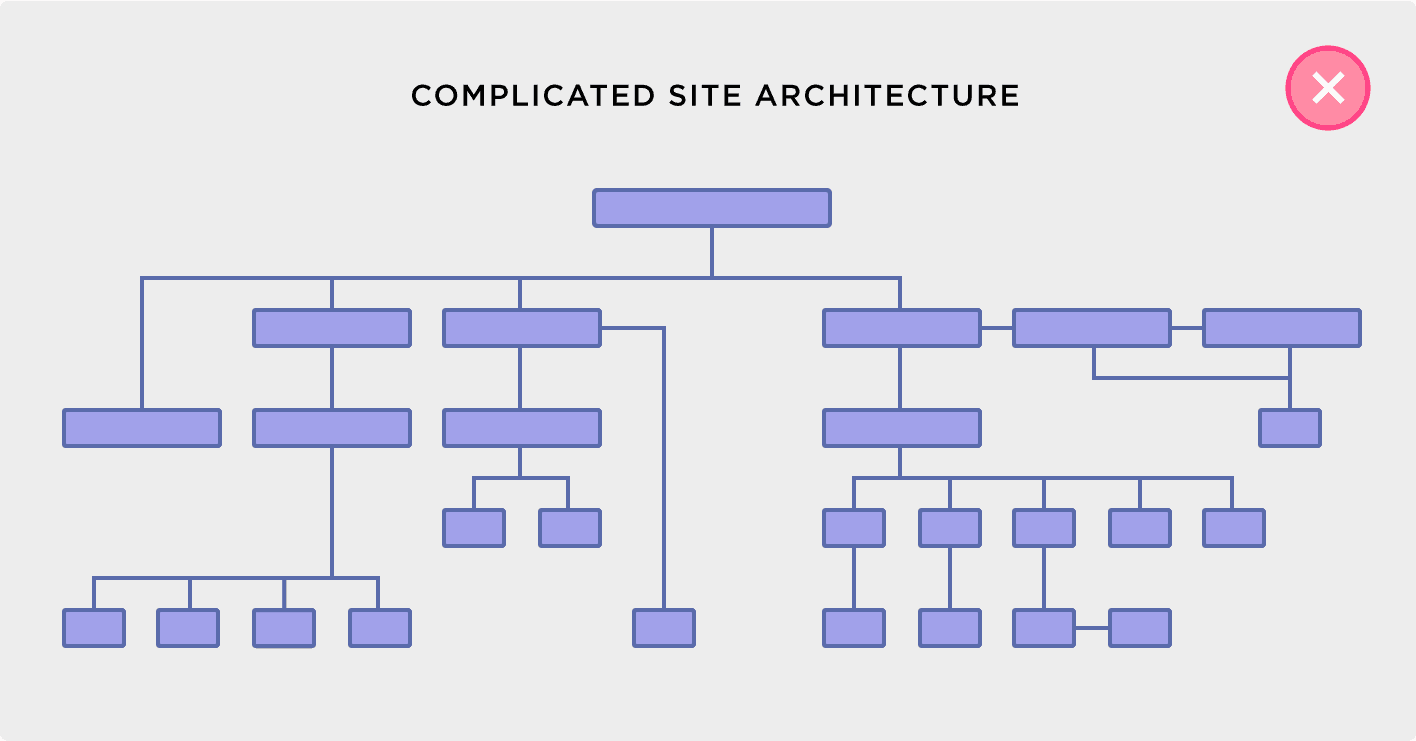
But when your site architecture links your pages together, Google can easily find and index your entire site.

Second, architecture tells Google which pages on your site are most important.
In general, the closer a page is to your homepage, the more important it is.
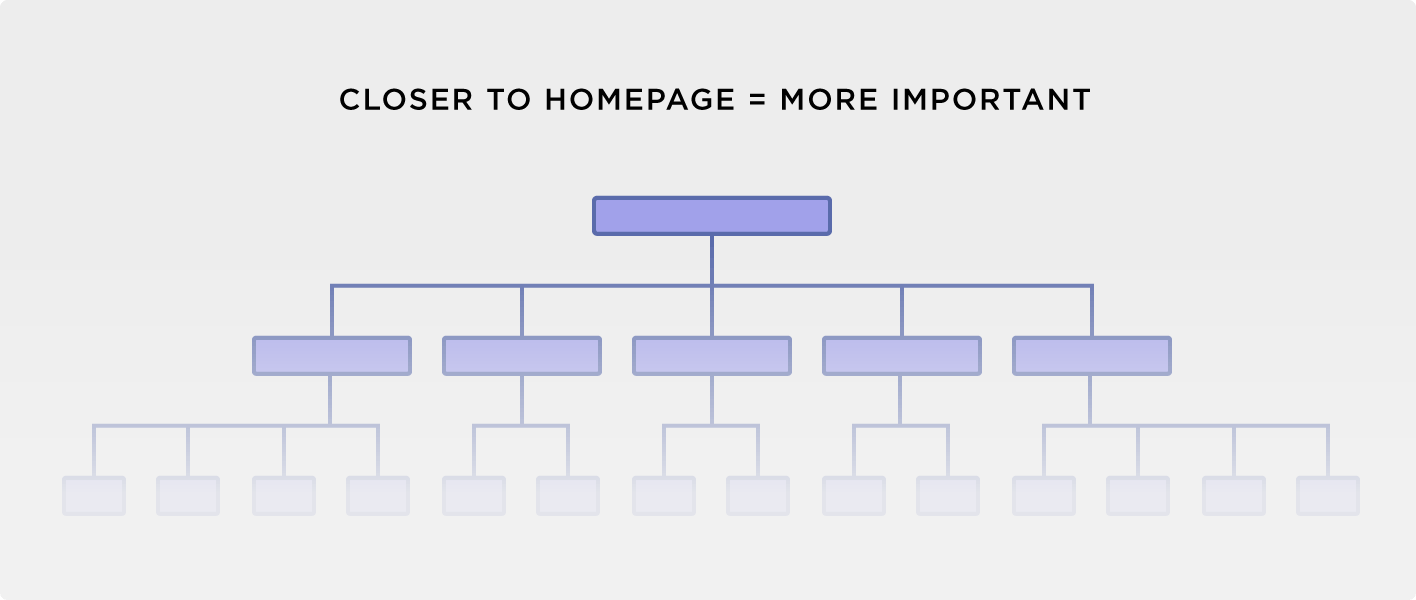
The question is:
How should your site’s architecture look?
Well, I know I said that this SEO audit wasn’t going to be super technical.
So I’m going to keep this super duper simple…
You want to keep your site architecture flat.
In other words, not like this:
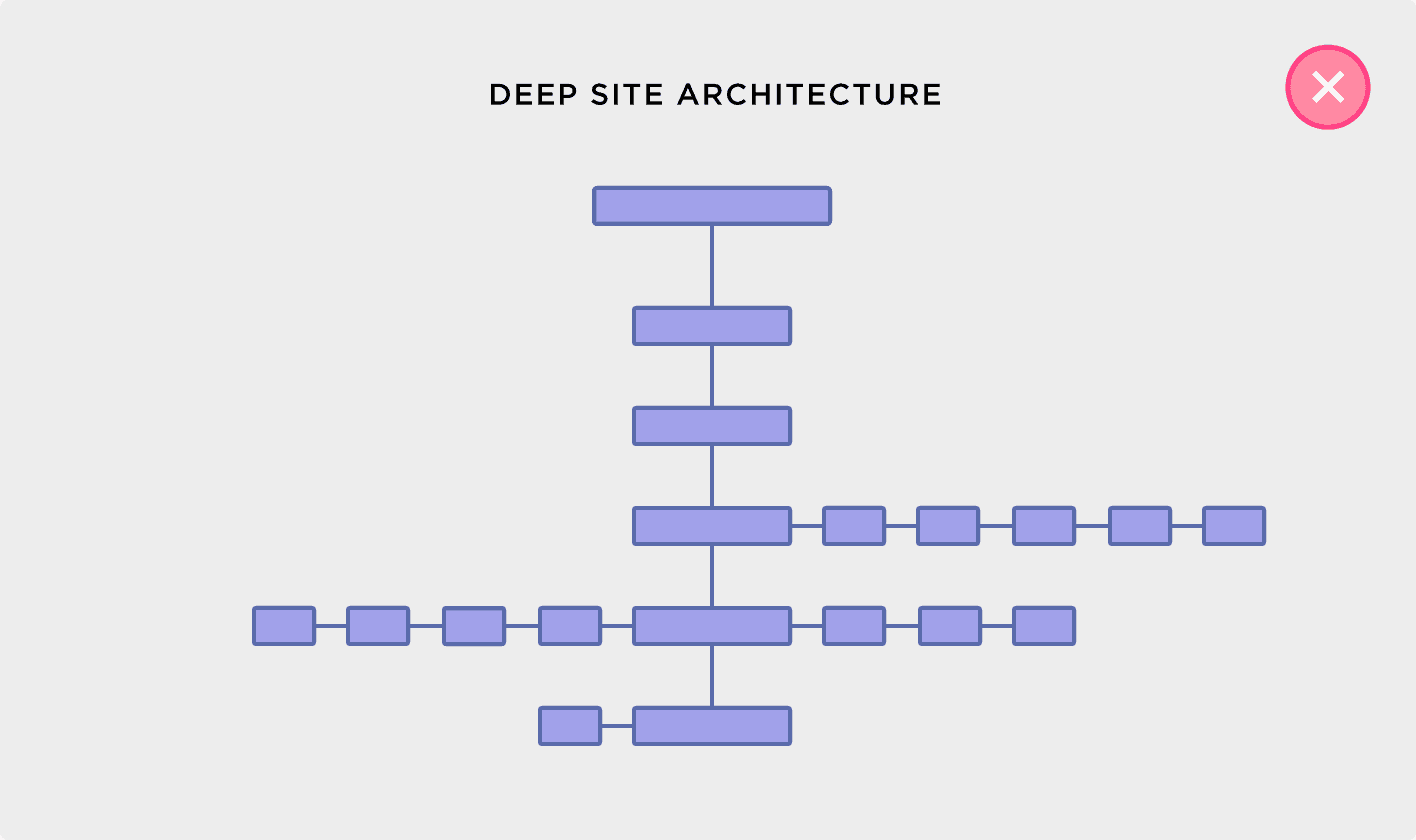
Instead, you want it to look like this:
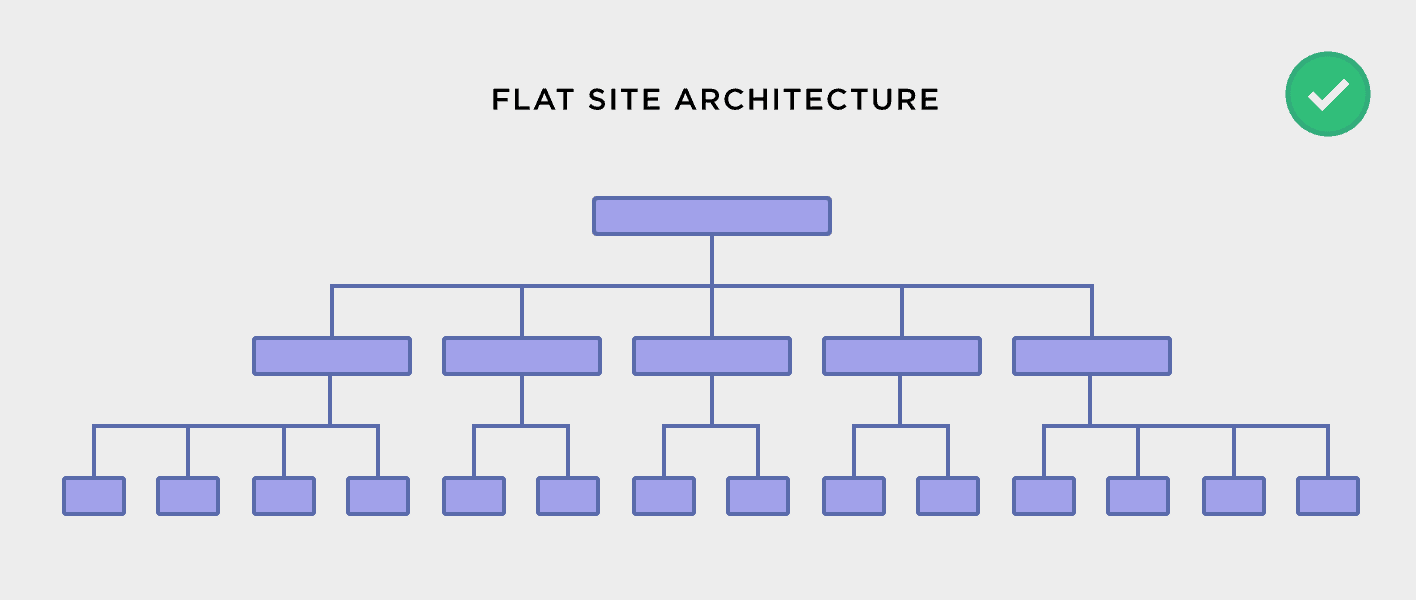
(Super flat.)
Or put another way:
It shouldn’t take more than 3 clicks to go from your homepage to any page on your site.

In some cases, you’ll need a developer to completely overhaul your site’s navigation.
But you can also just add internal links to different pages…
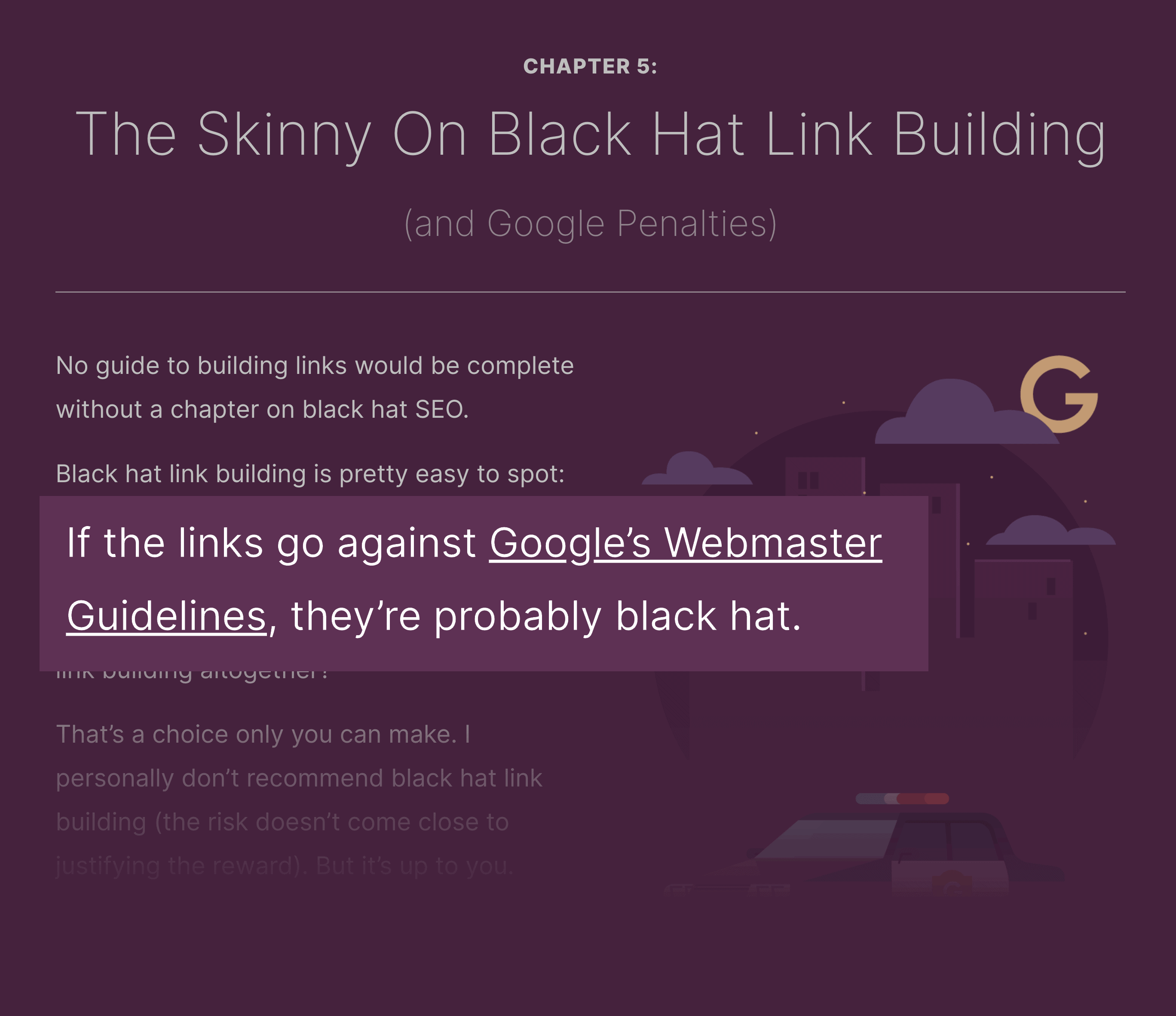
As long as users can reach any of your pages in 3 clicks or less, you’re good.
Step #15: Launch a Skyscraper Post
The last step of this SEO audit is to publish a piece of content using The Skyscraper Technique.
Why?
It helps Google quickly find and index all of the changes you just made.
For example, look at the spike in “Pages crawled per day” whenever I publish something new:
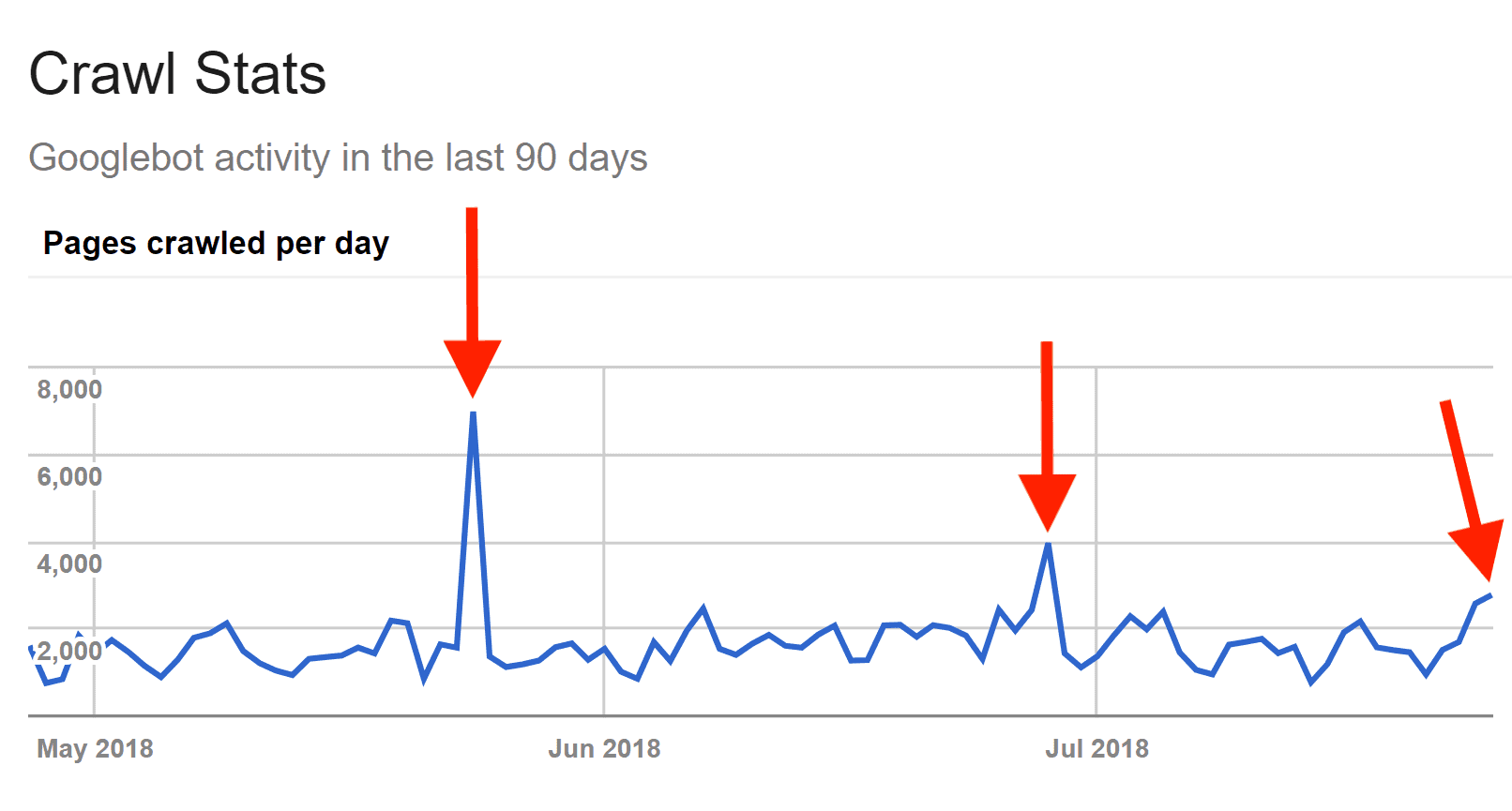
And this video will show you exactly how to execute the Skyscraper Technique process:
But as a quick recap, here’s how it works…
First, check out the top 10 results for a keyword that you want to rank for.
For example, some time ago, I published a piece of content called: “27 Ways to Increase Website Traffic”.
Before I wrote a single word, I analyzed the first page for keywords like “how to get more traffic”:

The content I found was pretty good. But nothing special.
Next, publish content that’s 5x better than what you found.
I took things up a notch with my post.
How?
I included lots of detailed steps:
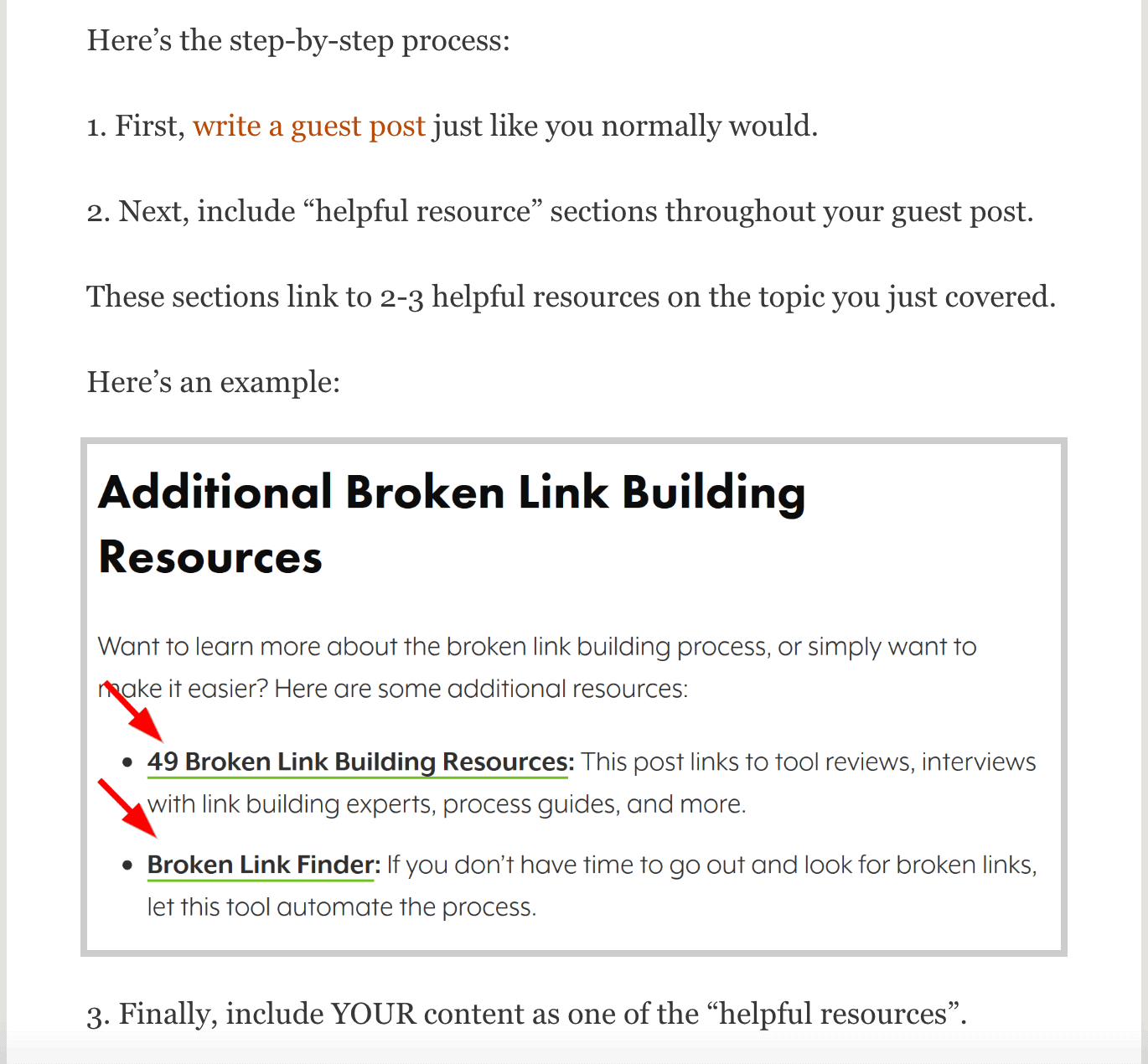
Screenshots:
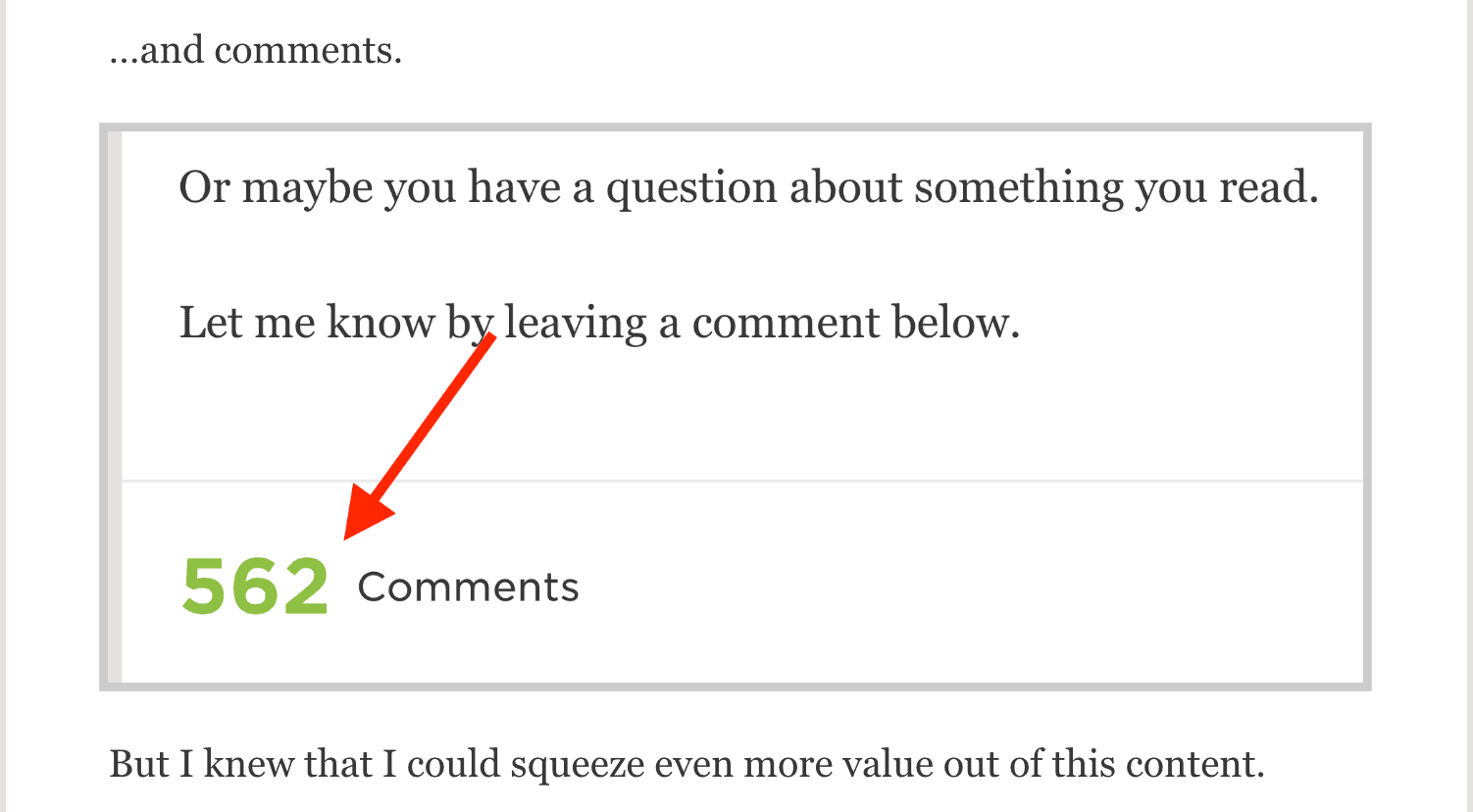
And techniques that are working RIGHT NOW:

Finally, it’s time to promote your post.
This is key.
When Google sees a flood of people (and links) coming to your site, they say: “This site is blowing up right now. We need to send Googlebot there right now.”
(As I mentioned earlier, this helps Google quickly process all of the changes you made to your site.)
In my case, I sent out a newsletter to my email subscribers:
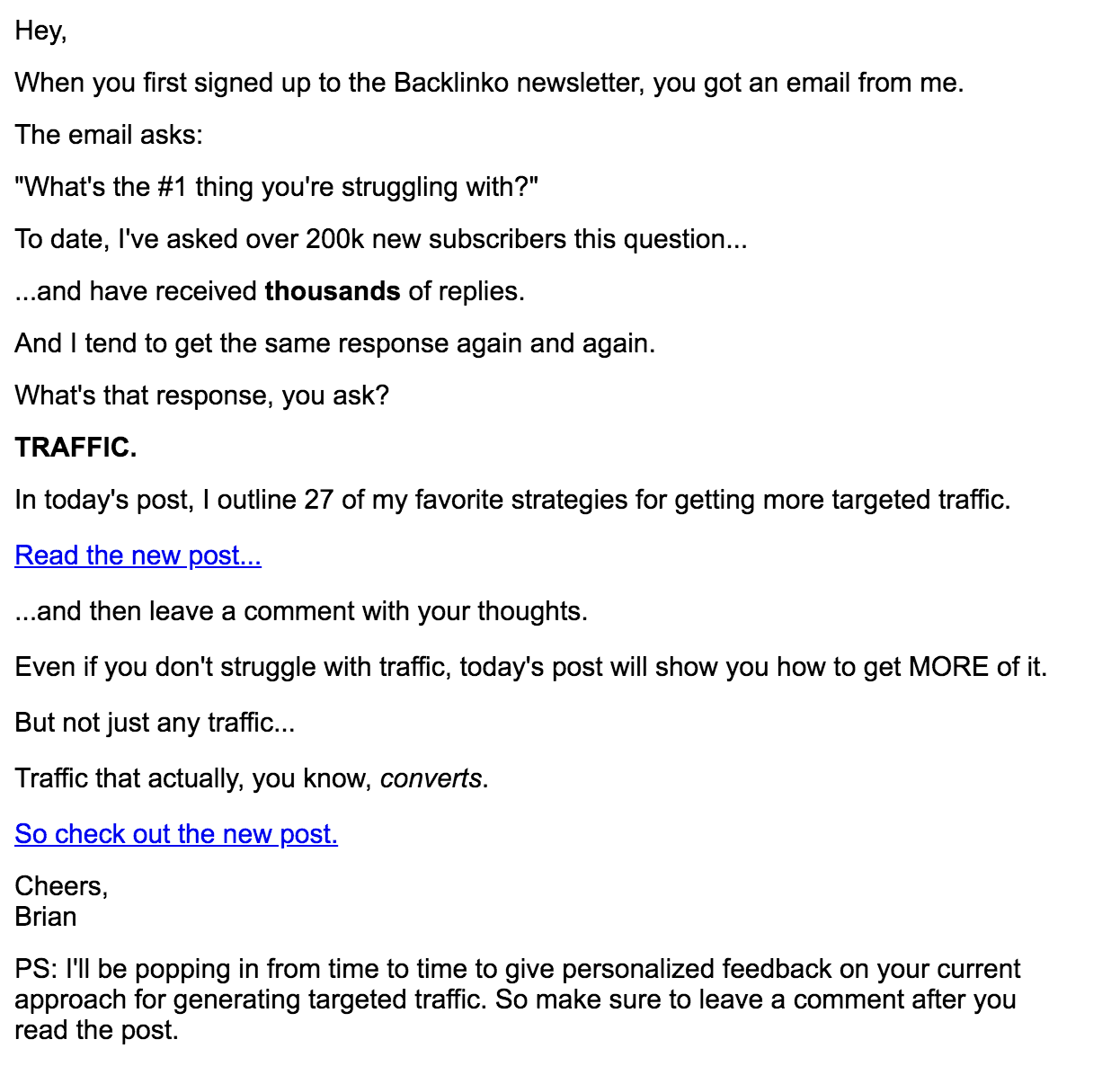
And promoted it on Facebook, LinkedIn and Twitter:
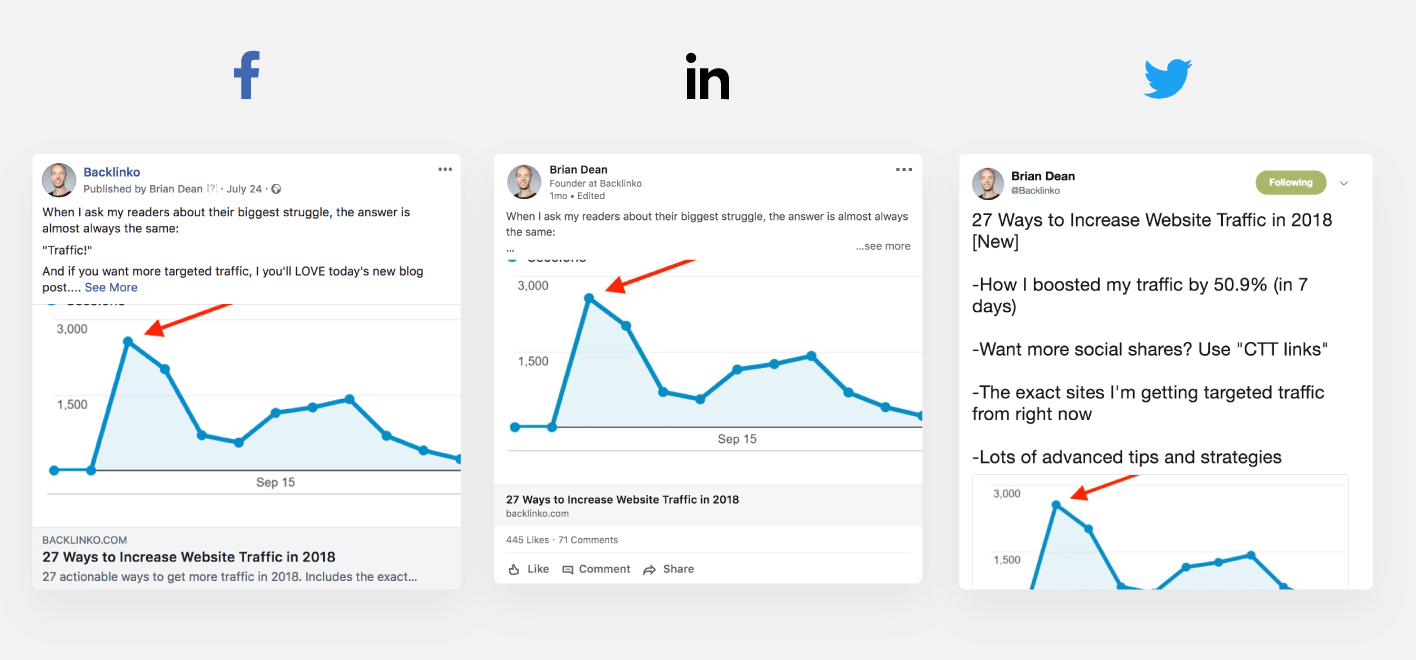
Bonus Step #1: Get More From Your Internal Links
Internal linking is one of the most underrated SEO strategies on the planet.
The question is:
How do you internal link the right way?
It’s simple:
Make sure you link to high-priority pages as much as possible.
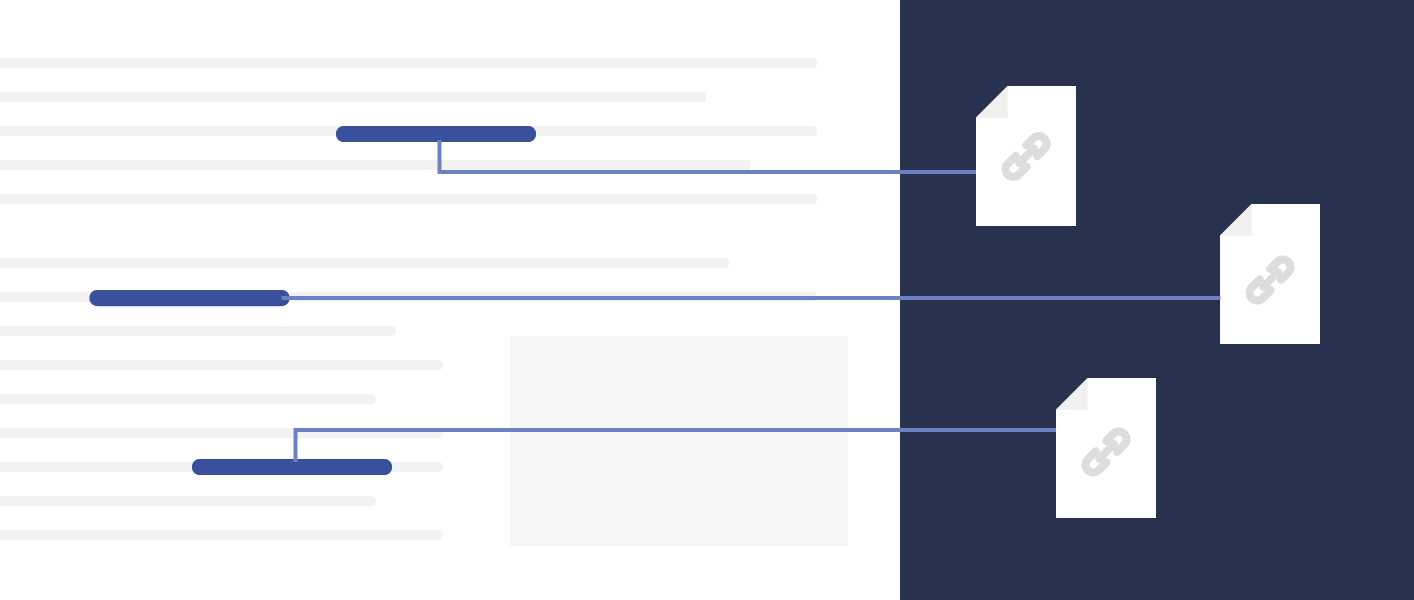
Pro Tip: You might find a handful of non-important pages in this report. For example, you might have lots of links pointing to your privacy policy or contact page. That’s usually because you link to those pages from your site’s navigation or footer. Don’t sweat it.
Bonus Step #2: Use a Site Audit Tool
I tried to keep this SEO audit process as non-techy as possible.
But if you want to dig deeper into your technical SEO, I highly recommend using an SEO audit tool.
Which tools do I recommend?
Actually, I use and recommend two.
The first is Seobility.

Unlike most audit tools, Seobility is VERY easy to use. Plus, the reports are simple to understand and take action on.
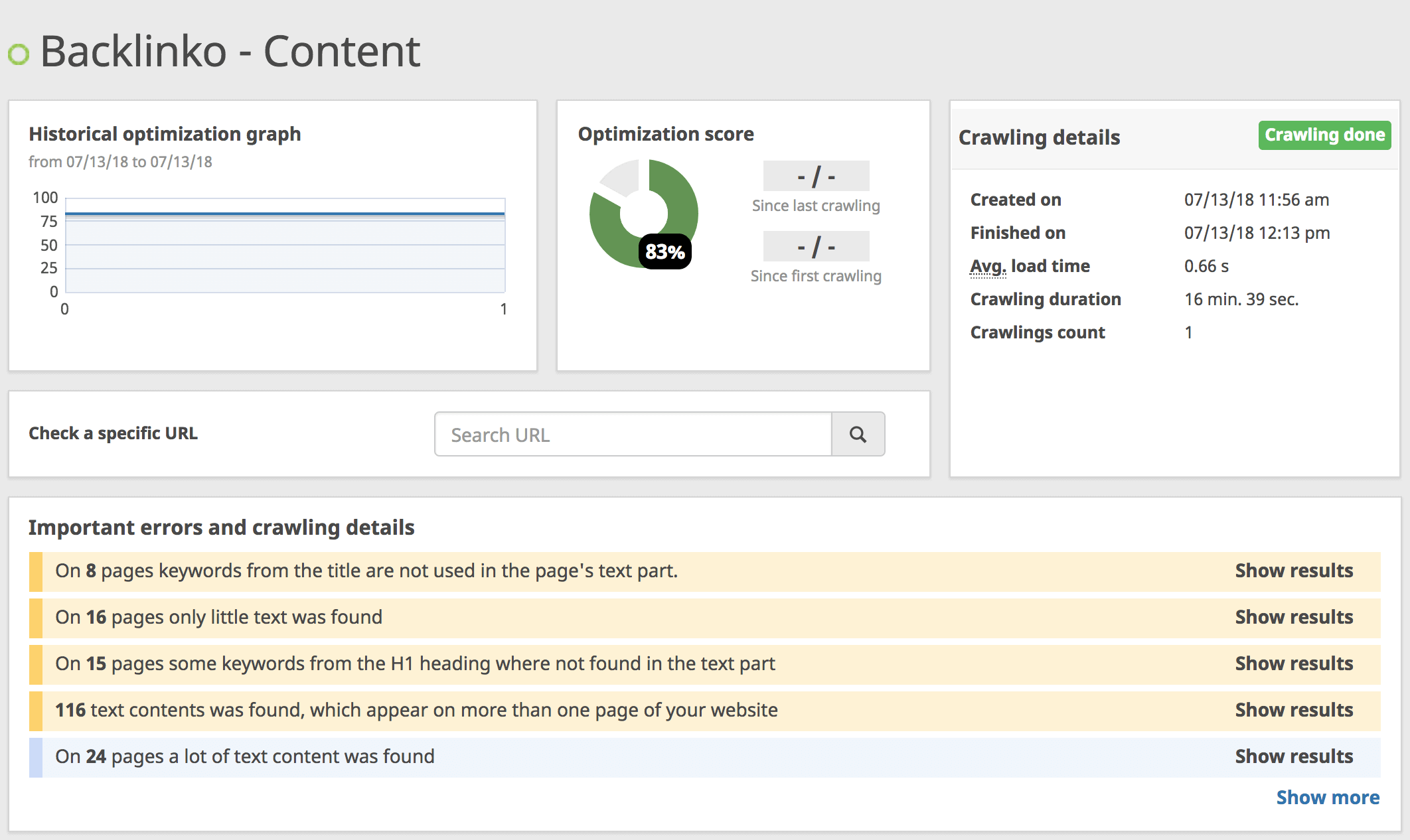
Even though SEMrush is mostly known as a keyword research tool, it has a surprisingly in-depth site audit feature.
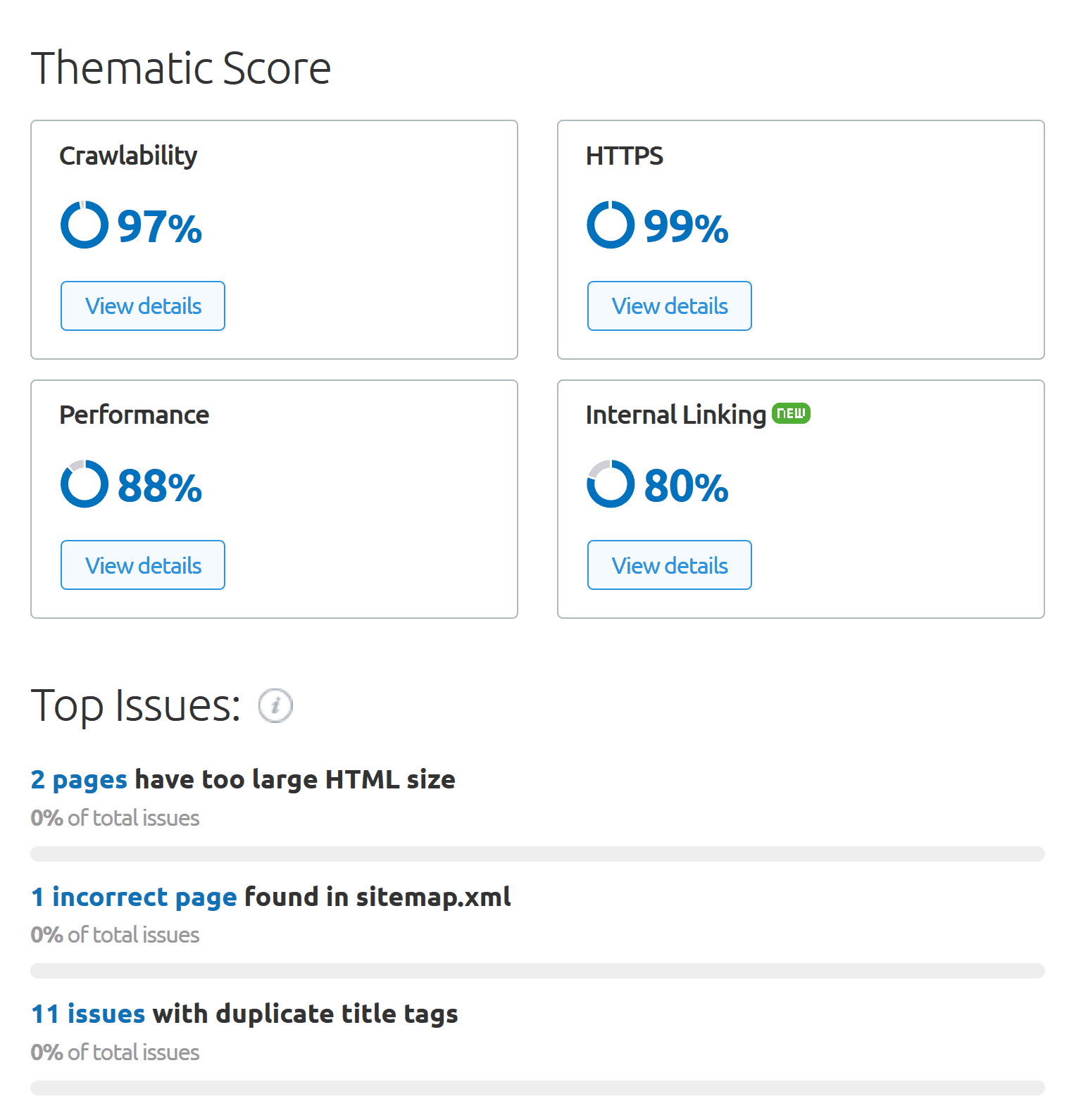
Bonus Step #3: Optimize for Featured Snippets
Featured Snippets can DRAMATICALLY increase your organic traffic.

For example, a while back I got this page to show up in the Featured Snippet spot.
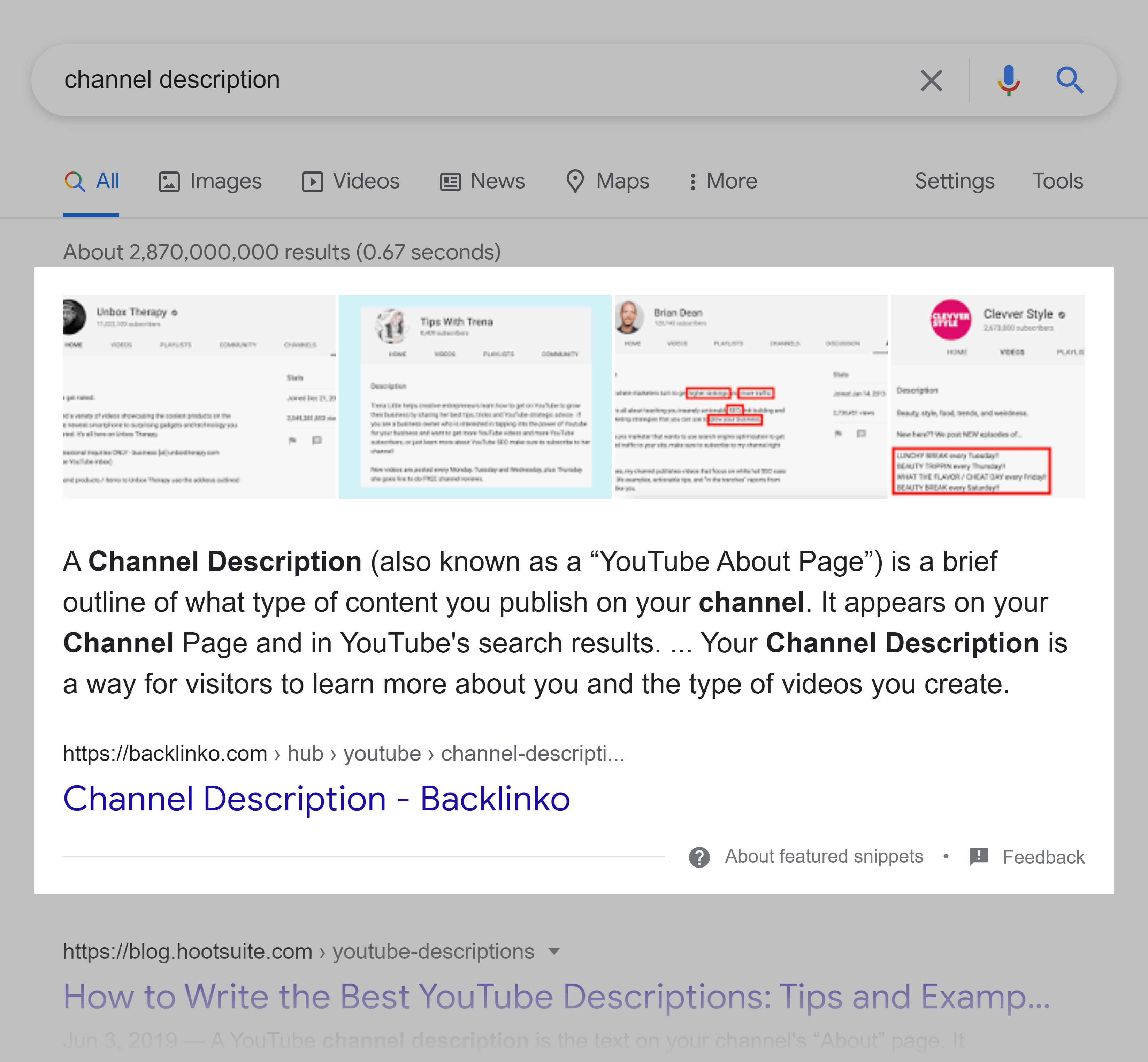
And organic traffic to that page shot up like a rocketship:

How do you get your content in the Featured Snippet spot?
To show up in the Featured Snippet, you need to…
- Have your content optimized for mobile
- Have HTTPS installed
- Use lots of headers (H2 and H3 tags)
- Include short answer to questions (42 words)
- Link out to authority resources
That’s about it 🙂
Now It’s Your Turn
That’s it for this SEO audit process.
And now I’d like to hear from you:
Do you have any questions about this process?
Or maybe you have a cool tip that I didn’t include here.
Either way, let me know by leaving a comment below right now.
© copyright 2019 – all rights are saved










1 Comment
Wow, superb weblog format! How long have you been running a blog for?
you make running a blog look easy. The full look of
your web site is great, let alone the content material! You can see similar here sklep